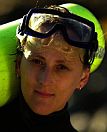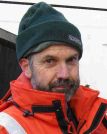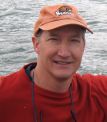PICES 2015 Annual Meeting Information and Presentations
Theme
General Information
Session 1: Science Board Symposium
Change and Sustainability of the North Pacific
-
Science Board Best Oral Presentation Award
Mitsutaku Makino (INVITED)
Toward the integrated research in fisheries science
Dr. Mitsutaku Makino is the Head of Fisheries Management Section of the Fisheries Research Agency, Japan. He is specializing in the fisheries and ecosystem-based management analysis. He is a Co-Chair of PICES S-HD and involved in many international scholarly programs such as IMBER Humand Dimension WG, IUCN Fisheries Expert Group (IUCN-FEG), etc. He teaches in several universities in Japan, and currently serves as an Editor of ICES Journal of Marine Sciencec. His recent book entitled "Fisheries Management in Japan" was published from Springer.
-
Science Board Best Poster Presentation Award
Jack Barth
Occurrence of demersal fishes in relation to near-bottom oxygen levels within the California Current large marine ecosystem
Co-Convenors:
Thomas Therriault (SB)
Angelica Peña (BIO)
Elizabeth Logerwell (FIS)
Chuanlin Huo (MEQ)
Jennifer Boldt (MONITOR)
Kyung-Il Chang (POC)
Toru Suzuki (TCODE)
Steven Bograd (FUTURE)
Hiroaki Saito (FUTURE)
Igor Shevchenko (Russia)
Invited Speakers:
Emanuele Di Lorenzo (Earth & Atmospheric Sciences, Georgia Institute of Technology, USA)
Mike Foreman (Fisheries and Oceans Canada, Canada)
Mitsutaku Makino (Fisheries Research Agency, Japan)
Leonie Robinson (University of Liverpool, UK)
George Waldbusser (Oregon State University, USA)
Since its establishment, PICES has provided leadership in developing a better understanding of the structure, function and changes of North Pacific marine ecosystems. The integrative scientific programs of PICES, and other special activities such as periodic Ecosystem Status Reports, have advanced our knowledge of coupled physical-biogeochemical-ecological processes of the North Pacific. The Forecasting and Understanding Trends, Uncertainty and Responses of North Pacific Marine Ecosystems (FUTURE) program is focusing on acquiring better insight into the combined consequences of climate change and anthropogenic pressures on marine ecosystems, ecosystem services and marine dependent social systems. Climate change research remains important to ocean scientists and governments within PICES. However, the direct and indirect interactions of human activities on coastal and open ocean ecosystems and the services they provide to society are also of great concern in the North Pacific area. A sustainable North Pacific ecosystem is desired by both the public and governments. This vision seeks a balance between resource protection and resource utilization, and a balance between pressing needs at local and regional scales and climate-driven issues at basin and global ocean scales. The nature of the Science Board symposium theme allows for scientific sessions to include topics on climate change, ocean acidification, coastal eutrophication, aquaculture, fishing, pollution, coastal development and planning, sustainability, resilience, vulnerability, cumulative impacts of multiple stressors, and the tradeoffs/conflicts inherent in multiple-use ocean activities, and mechanisms to resolve these. Presentations on the above topics and the relationship and compatibility of marine resource development, eco-environment sustainability, protection and restoration are welcomed for this session.
-
 S1 INVITED Presentation
S1 INVITED Presentation
Emanuele Di Lorenzo, Keith Criddle and Alida Bundy
Towards a social-ecological-environmental system approach for the coastal ocean
Dr. Emanuele Di Lorenzo is a Professor of Ocean and Climate Dynamics in the School of Earth and Atmospheric Sciences, Georgia Institute of Technology, U.S.A. He received his Ph.D. in oceanography at the Scripps Institution of Oceanography in 2003. His research interests and experience span a wide range of topics from physical oceanography to ocean climate and marine ecosystems. More specific focus is on dynamics of basin and regional ocean circulation, inverse modeling, Pacific low-frequency variability, and impacts of large-scale climate variability on marine ecosystem dynamics (http://www.oces.us). In PICES he is co-chair of the Working group on North Pacific Climate Variability & Change and member of the Climate Ocean Variability and Ecosystem Advisory Panel (COVE-AP). He also serves on the US Comparative Analysis of Marine Ecosystem (CAMEO) Science Steering Committee.
-
 S1 INVITED Presentation
S1 INVITED Presentation
Michael Foreman, Chan Joo Chan, Enrique Curchitser and Angelica Peña
Regional climate modeling and FUTURE - An overview and possible future directions
Michael Foreman is a Scientist Emeritus at the Institute of Ocean Sciences (Fisheries and Oceans Canada) where his research has included coastal biophysical modeling, climate change modeling and analyses, data assimilation, satellite altimetry analyses, and the analysis, prediction and modeling of tides. He has been active in PICES for many years, serving as Chair of the Physical and Oceanographic and Climate (POC) committee from 2005 to 2010 and Co-Chair of Working Group 20 (Evaluations of Climate Change Projections) from 2006 to 2010, and presently continuing as a member of POC, the Section of Climate Change Effects on Marine Ecosystems and Working Groups 27 (North Pacific Climate Variability and Change) and 29 (Regional Climate Modeling).
-
 S1 INVITED Presentation
S1 INVITED Presentation
George G. Waldbusser
Impacts of ocean acidification on bivalve production in the Pacific Northwest
George Waldbusser is an assistant professor of Ocean Ecology and Biogeochemistry in the College of Earth, Ocean, and Atmospheric Sciences at Oregon State University since late 2009. He completed a Ph.D. in Marine and Estuarine Environmental Science from the University of Maryland in 2008. Dr. Waldbusser’s interests broadly span marine ecology and biogeochemistry, with particular interests in animal sediment interactions, ocean acidification, marine invertebrate ecology, and estuarine biogeochemistry. His undergraduate degree in Environmental Science from St. John’s University in New York City and his childhood residence in that area fuels his interests in the interface between humans and the sea. He is also currently serving on the editorial board for the Journal of Shellfish Research and an Associate Editor for Limnology and Oceanography: Methods. Previously he has served on the Washington Governor’s Blue Ribbon Panel on Ocean Acidification and has recently joined The West Coast Ocean Acidification and Hypoxia Science Panel.
-
 S1 INVITED Presentation
S1 INVITED Presentation
Leonie A. Robinson
A European perspective on Integrated Ecosystem Assessment
Before joining the University of Liverpool, Dr Robinson completed a PhD at the University of Newcastle upon Tyne and a postdoctoral position at the Fisheries Research Services Marine Laboratory in Aberdeen, Scotland. Her research background is in community ecology of marine ecosystems with particular reference to understanding the drivers, both natural and anthropogenic, of variability in temporal and spatial dynamics. Her work currently focuses on the application of ecological theory in underpinning management of marine resources (particularly: ecosystem-based management; ecosystem approaches to fisheries management; integrated assessment). Leonie has recently led the pan-European EU FP7 project “ODEMM”: Options for Delivering Ecosystem-Based Marine Management, which has developed tools and understanding to help deliver the Marine Strategy Framework Directive. She is also a member of the ICES Working Group on Ecosystem Effects of Fishing.
Using earth systems model output to project climate change impacts to the North Pacific Subtropical Ecosystem over the 21st Century
Jeffrey Polovina and Phoebe Woodworth-Jefcoats
[pdf, 1 Mb]
Fighting a hard battle: Effects of hypoxia and temperature on euphausiids in the North Pacific
Lingbo Li, Julie E. Keister and Mei Sato
[pdf, 1 Mb]
Top predators partition the Bering Sea and are unlikely to respond favourably to climate change
Andrew W. Trites, B. Battaile, K.J. Benoit-Bird, A. Harding, S. Heppell, B. Hoover, D. Irons, N. Jones, K. Kuletz, C. Nordstrom, R. Paredes and D. Roby
[permission to post denied, contact presenter]
Jellyfish blooms as a threat to the sustainability of the East Asian Marginal Seas: An overview of recent jellyfish studies in China, Japan and Korea
Shin-ichi Uye, Hideki Ikdea, Sun Song, Fang Zhang, Chang-Hoon Han and Won-Duk Yoon
[pdf, 2.5 Mb]
Multiple scale climate variability in the North Pacific and features of recent climatic regime
Vladimir I. Ponomarev, Elena V. Dmitrieva and Svetlana P. Shkorba
[pdf, 2 Mb]
Anthropogenic aerosols and climate variability control decadal variability of dissolved oxygen in the North Pacific
Takamitsu Ito, Athanasios Nenes, Matthew S. Johnson, Nicholas Meskhidze and Curtis Deutsch
[being pubshed, will be posted later, contact presenter]
Social-ecological vulnerability of forage fish and fishermen to climate change
Jameal F. Samhouri, Lucas Earl, Caren Barcelo, Steven Bograd, Ric Brodeur, Lorenzo Cianelli, Emma Fuller, Elliott Hazen, Michael Jacox, Isaac Kaplan, Ryan Rykaczewski, Maria Dickinson Sheridan and Gregory D. Williams
[permission to post denied, please contact presenter]
POSTERS
Socio-ecological linkages enhancing the resilience of Japan’s Urato Islands
Akane Minohara and Robert Blasiak
Change of the dense bottom water production on the northern Okhotsk Sea shelf and its transport to the intermediate layer of the North Pacific
Yury Zuenko, Alexander Figurkin, Vladimir Matveev and Elena Ustinova
[pdf, 1 Mb]
Climatic changes of temperature, salinity and nutrients in the Amur Bay of the Japan Sea
Yury Zuenko and Vladimir Rachkov
[pdf, 0.5 Mb]
Geographic variation in Pacific herring growth in response to regime shifts in the North Pacific Ocean
Shin-ichi Ito, Kenneth A. Rose, Bernard A. Megrey, Jake Schweigert, Douglas Hay, Francisco E. Werner and Maki Noguchi
A multivariate assessment of eutrophication in three typical bays of the northern Zhejiang, East China Sea
Ran Ye, Xiansen Ye, Lian Liu, Min Ren, Qiong Wang, Kai Wang, Wei Cao, Qinyan He and Yanhong Cai
Change dynamics analysis of the shoreline using optical sensors in coastal stretch of Bay of Bengal, India
Swati Katiyar and Pavan Kumar
Seasonal variability of phytoplankton in the North Pacific and North Atlantic Ocean from space
Min Zhang, Yuanling Zhang, Fangli Qiao, Jia Deng and Gang Wang
A quantitative definition of global warming hiatus and 50-year prediction of global mean surface temperature
Meng Wei, Fangli Qiao and Jia Deng
Plankton distribution characteristics and its interactive relationship in southern waters of Miaodao Archipelago
Yuan-yuan Wang, Jie Liand Hong-hua Shi
Ichthyoplankton assemblage structure of spring in the Yangtze estuary revealed by biological and environmental visions
Hui Zhang, Weiwei Xian and Shude Liu
[pdf, 2 Mb]
The impact of winter East Asia Monsoon and ice coverage variation on Japanese scallop aquaculture in Saroma Lake, Japan
Yang Liu, Sei-Ichi Saitoh, Kimihiko Maekawa, Shouyi Yuan and Toru Hirawake
Evaluating management strategies of limited data species based on hierarchical demographic approaches: An example using yellow croaker (Larimichthys polyactis) along north Pacific coast of China
Yiping Ren, Yan Jiao, Ying Xue, Rong Wan and Qiuyun Ma
Climate change and the fishery in Russia-2030
Oleg Bulatov
The International Group for Marine Ecological Time Series (IGMETS): Assessing global oceanic changes through joint time series analysis
Andrew R.S. Ross, Nicholas Bates, Antonio Bode, James Cloern, Kirsten Isensee, Mike Lomas, Laura Lorenzoni, Anish Lotliker, Frank Muller-Karger, Todd O’Brien, Anthony Richardson, Luis Valdés and Peter Wiebe
[pdf, 4 Mb]
Island economic vulnerability to natural disasters – The case of Changdao
Zhiwei Zhang and Aiping Feng
Session 2: BIO/MONITOR/TCODE Topic Session
The 2014/15 El Niño and anomalous warming of the North Pacific: What happened?
Bill Peterson (USA)
Lisa Eisner (USA)
Tony Koslow (USA)
Invited Speakers:
Nicholas Bond (University of Washington, USA)
Emanuele Di Lorenzo (Earth & Atmospheric Sciences, Georgia Institute of Technology, USA)
Major El Niño events in 1982/83 and 1997/98 had massive impacts on the ecosystems of the North Pacific Ocean. In spring 2014, computer models were predicting another major El Niño for 2014/15. However, it now appears that the event is weakening (but who knows what the future holds). Despite this, it is perhaps more noteworthy that the entire Pacific north of ~35°N is anomalously warm with SSTs in the Gulf of Alaska that are >4σ above the long-term mean. This warming event appears to be unprecedented, with strong signals in the Gulf of Alaska and Bering Sea, and across the Pacific to Japan, as well as in the Oyashio, the Sea of Okhotsk and coastal waters surrounding Russia, Japan and Korea. Anomalous warming is also seen in the Arctic Ocean, Baffin Bay, the Labrador Sea and much of the far north Atlantic. Key questions to address in this session include what are the atmospheric conditions leading to wide-spread warming, what are the consequences for local weather, and, what are the consequences to ecosystem structure and fisheries? The purpose of this session is to encourage researchers to present evidence of anomalous behaviour in the ecosystems of the North Pacific. We are interested in descriptions of anomalous behaviour in the physical environment, the chemistry of the oceans and the biological impacts of the physical anomalies. The session will be a success if investigators with related stories are brought together to write joint papers describing the evolution and impacts of both the 2014/15 El Niño event as well as anomalous warming of the North Pacific (and perhaps the North Atlantic and adjacent seas).
-
 S2 INVITED Presentation
S2 INVITED Presentation
Nicholas A. Bond and Meghan Cronin
Causes and effects of the recent warming in the Northeast Pacific Ocean
Nick Bond is a principal research scientist with the Joint Institute for the Study of the Atmosphere and Ocean (JISAO) of the University of Washington (UW) and also holds an appointment as an affiliate associate professor with the Department of Atmospheric Sciences at the UW. He is the State Climatologist for Washington. He has a Ph.D. in Atmospheric Sciences from the University of Washington. His research is on a broad range of topics with a focus on the weather and climate of the Pacific Northwest and the linkages between the climate and marine ecosystems of the North Pacific. He cheerfully admits to being a weather geek, as evidenced by his preference to visit Alaska in winter, and steamy places like Florida in summer.
-
 S2 INVITED Presentation
S2 INVITED Presentation
Emanuele Di Lorenzo and Nathan Mantua
Persistent record-high temperatures in the North Pacific in 2014/2015: A climate hypothesis
Dr. Emanuele Di Lorenzo is a Professor of Ocean and Climate Dynamics in the School of Earth and Atmospheric Sciences, Georgia Institute of Technology, U.S.A. He received his Ph.D. in oceanography at the Scripps Institution of Oceanography in 2003. His research interests and experience span a wide range of topics from physical oceanography to ocean climate and marine ecosystems. More specific focus is on dynamics of basin and regional ocean circulation, inverse modeling, Pacific low-frequency variability, and impacts of large-scale climate variability on marine ecosystem dynamics (http://www.oces.us). In PICES he is co-chair of the Working group on North Pacific Climate Variability & Change and member of the Climate Ocean Variability and Ecosystem Advisory Panel (COVE-AP). He also serves on the US Comparative Analysis of Marine Ecosystem (CAMEO) Science Steering Committee.
Arrival of 2014-2015 Warm Anomaly waters off Oregon
P. Michael Kosro, Craig Risien, John A. Barth, Alexander Kurapov, R. Kipp Shearman and P. Ted Strub
[
pdf,
2.5 Mb
]
Phytoplankton responses to the anomalous warming in the NE Pacific
Angelica Peña, Nina Nemcek and Marie Robert
[permission to post denied, contact presenter]
Warm Blob effects on subtropical NE Pacific Ocean phytoplankton
Eliana Gómez-Ocampo and Gilberto Gaxiola-Castro
[
pdf,
1 Mb
]
The effects of the anomalous warming on lower trophic levels in the NE Pacific, from Continuous Plankton Recorder sampling
Sonia Batten
[pdf, 2.5 Mb]
The effects of The Blob on the zooplankton and upper trophic levels of the Northern California Current off Oregon
William T. Peterson, Jennifer Fisher, Jay Peterson and Tracy Shaw
Presented by Anthony Koslow on behalf of William T. Peterson
[pdf, 1.5 Mb]
Observations of anomalously low crustacean zooplankton production rates along the west coast of Vancouver Island in the spring of 2015
Akash R. Sastri, John F. Dower, Aidan Neill, R., Karyn D. Suchy, Moira Galbraith, Kelly V. Young and R. Ian Perry
[
pdf,
1.5 Mb
]
Ichthyoplankton and corrosive waters off southern California
Sam McClatchie, Andrew R. Thompson and William Watson
[
pdf,
1 Mb
]
Anomalous patterns in California Current pelagic micronekton distribution and abundance in 2015
John C. Field, Keith M. Sakuma, Baldo B. Marinovic, Cynthia N. Carrion and Nathan J. Mantua
[pdf, 3 Mb]
Preliminary observations of the impact of the BLOB on the summer distribution of marine fish in the Gulf of Alaska
Anne B. Hollowed, Chris Wilson and Wayne Palsson
[waiting for permission]
Anomalous warming and its impacts in the NE Pacific from a Canadian perspective
R. Ian Perry, Moira Galbraith, Peter Chandler, Howard Freeland, John Dower, Akash Sastri, Mark Hipfner, Jennifer Boldt and Marc Trudel
[pdf, 2 Mb]
Anomalously warm conditions during 2013-2015 off the California Coast
Yi Chao, John Farrara and Fei Chai
Presented by Fei Chai on behalf of Yi Chao
[permission to post denied, contact presenter]
Session 3: FIS Topic Session
Eastern-western approaches to fisheries: resource utilization and ecosystem impacts
-
FIS Committee Best Oral Presentation Award
Shengle Yin
Selection of suitable coastal aquaculture sites with environmental and socio-economic consideration: A case study in the Menai Strait, UK
Co-Convenors:
Gordon H. Kruse (USA)
Shijie Zhou (Australia)
Xianshi Jin (China)
Jacquelynne King (Canada)
Mitsutaku Makino (Japan)
Marie-Joëlle Rochet (France)
Invited Speakers:
Xianshi Jin (China)
Marie-Joëlle Rochet (France/ICES)
Shijie Zhou (Australia)
FUTURE endeavors to develop a better understanding of the combined consequences of climate change and anthropogenic pressures on marine ecosystems, ecosystem services and marine-dependent social systems. Although climate change has garnered much deserved attention so far, the direct and indirect interactions of human society on marine ecosystems and the services they provide are also of great concern. Fisheries are major contributors to global food security, while also posing threats to some ecosystem services. Rising demand for seafood and increasing concerns about the ecosystem effects of fishing create a fisheries management dilemma. Improved understanding about how human activities alter marine ecosystem structure and function is central to exploring options to procure food security in the future. In North America and Europe, emphasis is placed on conservative catch limits for fisheries that are highly selective for large-sizes of certain species. In Asia, a wide spectrum of fish species and sizes enter seafood markets, and less emphasis is placed on constraining catches. Both approaches affect ecosystem structure and functioning. By comparing approaches, can East and West learn from each other? Although questions about how to increase fisheries production while reducing environment impacts are not new, new ideas have entered the debate. For example, “balanced exploitation” advocates sustainable removal levels that strive to maintain natural balance among species, stocks, sexes, and sizes, thus preserving biodiversity. Yet, fisheries are commercial enterprises that must supply consumers with seafood at a profit. Also, fishing represents a diversity of lifestyles that span small-scale, artisanal fishers to large multinational corporations. This topic session provides a forum to compare and contrast alternative fishing strategies for sustainable global food security. Presentations are sought on the effects of fishing on ecosystem structure and function, cultural practices and institutional programs to manage bycatch and discards, better utilization of fishery resources, diversification of seafood products and markets, economic considerations, and many facets of human dimensions. Seafood industry representatives from Eastern and Western cultures will be invited to contribute their perspectives.
-
 S3 INVITED Presentation
S3 INVITED Presentation
Xianshi Jin and Xiujuan Shan
The marine fisheries resource utilization, ecosystem impacts and fisheries management in China
Dr. Xianshi Jin is a senior scientist in fisheries biology and director of Yellow Sea Fisheries Research Institute, CAFS, China. He received his PhD in fisheries science at University of Bergen in 1996. His research interests and experience span a wide range of topics, including stock assessment, fisheries ecology, and stock enhancement, as well as ecosystem dynamics. In PICES he is vice-chairman of Fishery Science Committee.
-
 S3 INVITED Presentation
S3 INVITED Presentation
Marie-Joëlle Rochet, Verena Trenkel and Laurence Fauconnet
The Landing Obligation in the European Union Common Fisheries Policy: Can a regulation focused on resource utilization address broader management objectives such as limited environmental impacts, economic development, and food supply?
Dr. Marie-Joëlle Rochet is a senior scientist at Ifremer, France, for 23 years. She has developed research in the fields of fisheries and quantitative ecology. She was first interested in the effects of fishing on fish life history traits. Then she contributed to develop indicators of fishing impacts on fish populations and communities, with a special attention to size-based approaches. She fostered the use of qualitative modelling to integrate information across indicators and organization levels, and identify causes of changes to determine appropriate management actions. As such, she has been a long-term member of ICES Working Group on Ecosystem Effects of fishing, and contributed to the development of tools to implement the European Union Marine Strategy Framework Directive. She is also interested in fisheries discards at sea. She is the coordinator of the French national onboard sampling programme; she conducted research on sampling and estimation methods, and on the factors that affect discard amounts. She is currently involved in providing knowledge and advice to implement the landing obligation which is part of the recently launched European Common Fisheries Policy. In 2008 she was awarded the Pew Fellowship in Marine Conservation to determine which of selective or non-selective fishing is less harmful to the marine ecosystem.
-
 S3 INVITED Presentation
S3 INVITED Presentation
Shijie Zhou
Alternative fishing strategies and their consequences
[permission to post not granted, contact presenter]
Dr. Shijie Zhou is a Principal Research Scientist at CSIRO’s Oceans and Atmosphere Flagship, Australia. Early in his career, Shijie was interested in fish biology and behaviour when he was a lecturer in Xiamen University, China. He received his Ph.D. in Fisheries from University of Alaska Fairbanks and worked on crab biology, fisheries, and gear technology with the State of Alaska, USA. He became a Biometrician and Natural Resource Specialist in the State of Oregon, working on salmon stock assessment and management. At the same period he was a member of Chinook Technical Committee in the US-Canada Joint Pacific Salmon Commission and a member of Scientific and Statistical Committer of the Pacific Fisheries Management Council. In CSIRO, he undertakes research on fishery and ecosystem dynamics modeling. He also leads research in developing novel methods in population dynamics and ecological risk assessment. His current research interests include fisheries stock assessment, bycatch and discards, methods for data poor species, Bayesian modelling, and fisheries management. He has published over 100 research papers and scientific reports and is an Editor for the ICES Journal of Marine Science.
Exploitation and management of fisheries resources in northern South China Sea
Zuozhi Chen and Yongsong Qiu
[permission to post not granted, contact presenter]
An ecosystem-based fishery management approach toward sustainable groundfish resource utilization in the eastern Bering Sea
Gordon H. Kruse
[pdf, 3.5 Mb]
Optimization of sampling design for a fishery-independent survey with multiple objectives
Binduo Xu, Yiping Ren, Yong Chen, Chongliang Zhang, Ying Xue and Rong Wan
[pdf, 1 Mb]
Effects of changes in marine ecosystem services on human well-being: International comparison of human well-being structure
Juri Hori and Mitsutaku Makino
[pdf, 1 Mb]
Exploiting the natural productivity of aquatic ecosystems
Richard Law, Gustav W. Delius, Jeppe Kolding and Michael J. Plank
[permission to post not granted, contact presenter]
The effects of fishing on ecosystem structure of the Northeastern part of the Okhotsk Sea
Konstantin M. Gorbatenko, Vladimir V. Kulik and Artem E. Lazshentsev
[pdf, 2 Mb]
Modeling interannual variations of Japanese common squid (Todarodes pacificus) resources around Japan
Xinyu Guo, Yucheng Wang, Taishi Kubota and Naoki Yoshie
[permission to post not granted, contact presenter]
Management of small yellow croaker, Larimichthys polyactis stock in Korean waters using a length-based production value-per-recruit analysis
Hyun A Kim, Young Il Seo and Chang Ik Zhang
[waiting for permission]
Changes in ecological characteristics of walleye pollock Gadus chalcogrammus in accordance with the biomass fluctuation
Minkyoung Bang, Sukyung Kang, Suam Kim and Myong Ho Shon
[permission to post not granted, contact presenter]
Acceptable Biological Catch in the ecosystem-based TAC management
Hee Joong Kang, Young Il Seo and Chang Ik Zhang
[pdf, 1 Mb]
Assessment of Korean pollock population under data-limited situation
Saang-Yoon Hyun and Kyuhan Kim
Fishery stock assessment and management system in Japan
Tetsuichiro Funamoto
Redistribution of anchovy (Engraulis japonicus) wintering stock under climate change scenarios in the Yellow Sea
Yunlong Chen, Xiujuan Shan, Fangqun Dai and Xianshi Jin
Efficacy of fishery closure in rebuilding depleted stocks: Accounting for trophic interactions
Chongliang Zhang, Yong Chen and Yiping RenCollege of Fisheries, Ocean University of China, Qingdao, PR China
Session 4: MEQ Topic Session
Indicators of emerging pollution issues in the North Pacific Ocean
Co-Convenors:
Peter S. Ross (Canada)
Olga Lukyanova (Russia)
Invited Speakers:
Tomohiko Isobe (National Institute for Environmental Studies, Japan)
Hyo-Bang Moon (NOWPAP, Korea)
Vladimir Shulkin (NOWPAP, Russia)
Hideshige Takada (NOWPAP, Japan)
This session led by the Working Group on Emerging Topics in Marine Pollution (WG-ETMP) anticipates wide-ranging interest from a number of disciplines. The session aims to attract presentations on the use of sediments, shellfish, fish, seabirds, and marine mammals as indicators of marine pollution. Novel approaches and study designs will be discussed, with the aim of providing managers, regulators and scientists with timely feedback on emerging pollution threats. Depending on the study design and sample matrix, it is expected that pollutants to be discussed will include hydrocarbons, organochlorine pesticides, flame retardant chemicals, metals, pharmaceuticals, microplastics and other contaminants. Presentations that provide insight into the identification of contaminants of emerging concern, the ranking of priority pollutants from multiple sources, and the assessment of the relative importance of pollutants among other natural and anthropogenic stressors are encouraged. Presenters will be invited to contribute to a special issue of a scientific journal.
-
 S4 INVITED Presentation
S4 INVITED Presentation
Tomohiko Isobe, Yuko Tajima, Tadasu K. Yamada, Masao Amano, Takashi Matsuishi, Tatsuya Kunisue and Shinsuke Tanabe
Levels and temporal trends of legacy and emerging POPs in small cetacean species from Japan
[permission to post not granted, contact presenter]
Tomohiko Isobe is a senior researcher at Center for Environmental Health Sciences, National Institute for Environmental Studies, Japan. He received PhD from Tokyo University of Agriculture and Technology in 2001. He had been working for National Institute for Environmental Studies and Ehime University as a postdoc fellow and associate professor and moved back to the present institute last year. His research interests are developing a new analytical method for emerging contaminants of concern and investigating the environmental fate, spacio-temporal trend and bioaccumulation of contaminants in the ecosystem. He published highly cited papers in peer-reviewed journals, which are dealing with endocrine disrupting chemicals, steroid hormones, persistent organic pollutants and flame retardants in aquatic environment and biota, especially cetacean. Now he is involved in the nationwide birth cohort study, The Japan Environment and Children's Study (JECS), to evaluate the impact of various environmental factors on children's health and development.
-
 S4 INVITED Presentation
S4 INVITED Presentation
Yunsun Jeong, Hyun-Kyung Lee, Xiangzi Jin, Sunggyu Lee and Hyo-Bang Moon
Monitoring of legacy and emerging contaminants in wildlife from Korea
[permission to post not granted, contact presenter]
Dr. Hyo-Bang Moon is an Associate Professor at the Department of Marine Sciences and Convergent Technology in Hanyang University, Ansan, Korea. During 1999-2010, he had worked for the National Fisheries Research Development Institute (NFRDI) as a research scientist. He was responsible for the monitoring of the persistent organic pollutants (POPs) such as dioxins, PCBs and organochlorine pesticides in water, sediment and biota from Korean coastal waters. He is an environmental analytical chemist with good knowledge in atmospheric chemistry, atmospheric chemistry and wildlife and human health risk assessment for POPs. Since 1999, he has published over 140 peer-reviewed articles (including 60 articles published in Korean journals) which are related to marine pollution, air pollution, environmental chemistry and human health risk assessment. His current research projects include investigation on distribution, sources and bioaccumulation of emerging POPs (e.g. brominated flame retardants, perfluorinated compounds and their alternatives) in fresh/coastal waters, marine mammal toxicology, human exposure pathway of toxic chemicals to general population (e.g. food ingestion, inhalation and dust contact) and child health risk assessment by exposure to PBDEs and PFCs (maternal transfer and breast milk). In 2002-2010, Dr. Moon joined a national delegate for Korean side in the International Whaling Commission (IWC) and Northwest Pacific Action Plan (NOWPAP) Working Group 1 (Atmospheric Deposition). In 2009, Dr. Moon was an organizer for two international symposiums entitled ‘persistent organic pollutants (POPs) and endocrine disrupting chemicals (EDCs) in coastal and marine environment’ held in Busan, Korea. He is now an editorial board member of Ecotoxicology and Environmental Safety, Bulletin of Environmental Contamination and Toxicology, Journal of Emerging Contaminants, Ocean Science Journal, a section editor (Aquatic Environment) for Fisheries Science and Technology (KOFAS Press, Korea) and an associate editor for Toxicology and Environmental Health Sciences (ToxEHS Press, Korea).
-
 S4 INVITED Presentation
S4 INVITED Presentation
Vladimir M. Shulkin and Victor Ya. Kavun
Spatial variability of trace metal concentrations in different mussels from coastal areas of the northwestern Pacific Ocean
Dr. Vladimir Shulkin is a head of geochemical laboratory in the Pacific Geographical Institute of Far Eastern Branch Russian Academy of Sciences in Vladivostok. He is also a focal point at the CEARAC and POMRAC activity centers of UNEP NOWPAP. He received his PhD in marine geochemistry from Shirshov’s Institute of Oceanology, Moscow. His main interests include the biogeochemical processes in the estuaries and adjacent coastal waters, and the research on the contamination of the aquatic and terrestrial ecosystems by trace elements including biomonitoring aspects. He is involved in the current projects on the study of the influence of river runoff on the geochemistry of trace metals and phytoplankton productivity in the estuaries and coastal sea waters. The regional assessment of the ecological status, problems and trends in the Northwest Pacific including the analysis of water quality monitoring methods and data compatibility is also in the field of his research.
-
 S4 INVITED Presentation
S4 INVITED Presentation
Hideshige Takada, Rei Yamashita, Yohei Okazaki, Bee Geok Yeo, Ryu Yoshida, Atsuko Kondo and Yu Saito
Microplastic: An emerging threat to marine environment and a new tool for POP monitoring
Dr. Hideshige Takada received his Ph.D. from the Tokyo Metropolitan University (Environmental Organic Geochemistry) in 1989. He has been working in Tokyo University of Agriculture and Technology as an assistant professor, an associate professor, and a professor for 29 years. His specialty is trace analysis of organic micropollutants. The target compounds include persistent organic pollutants (POPs; e.g., PCBs, DDTs, PAHs), endocrine disrupting chemicals (e.g., nonylphenol, bisphenol A), pharmaceuticals (e.g., triclosan, sulfamethoxazole) as well as anthropogenic molecular markers (e.g., linear alkylbenzenes, coprostanol, artificial sweeteners, benzothiazoles, crotamition). His research field encompasses from Tokyo Bay and its vicinities to Southeast Asian to Africa.
In 2005, Hideshige Takada started International Pellet Watch, global monitoring of POPs by using beached plastic resin pellets (http://www.pelletwatch.org/). He has been working with ~ 50 NGO and individuals who have concern about marine plastic pollution. International Pellet Watch tells us the risk associated with chemicals accumulated in plastic debris in marine environments and their potential adverse effects on marine ecosystem.
Hideshige Takada is an author of more than 140 peer-reviewed papers in international journals and more than 25 invited conferences.
Microplastic is the macroproblem of the world’s oceans, including the Russian Far East
Iana Blinovskaia
[pdf, 2.5 Mb]
At-sea distributions reveal where Cassin’s Auklets are exposed to microplastics in the fall in British Columbia 2014
Patrick D. O’Hara, Jocelyn Wood, Stephanie Avery-Gomm, Laurie Wilson, Ken H. Morgan and Peter S. Ross
[pdf, 2 Mb]
Spatial and temporal mercury trends in seabird eggs from Pacific Canada 1968-2012 are due to diet: Evidence from sulfur isotopes
Kyle H. Elliott and John E. Elliott
[waiting for permission]
Mercury speciation and major factors controlling the cycling of methylmercury in the Yellow Sea and Bohai Sea, China
Yanbin Li, Lufeng Chen and Yongguang Yin
[permission to post not granted, contact presenter]
Persistent organic pollutants in the food chain: Salmon, seabirds and marine mammals from the North-West Pacific (Russian Far East)
Vasiliy Yu. Tsygankov, Margarita D. Boyarova, Peter A. Tyupeleev, Ilya А. Shcherbakov, Olga N. Lukyanova and Nadezhda K. Khristoforova
[pdf, 2 Mb]
Emerging ocean pollution issues in the NE Pacific Ocean vary by matrix: Lessons from sediments, shellfish and marine mammals
Peter S. Ross, Carmen Morales-Caselles and Marie Noel
[pdf, 1 Mb]
Bioindicators of marine pollution in impacted areas of the Sea of Okhotsk
Olga N. Lukyanova, Elena V. Zhuravel, Denis N. Chulchekov, Olga V. Podgurskaya and Andrey A. Mazur
[pdf, 1.5 Mb]
Acute effects of emamectin benzoate on the calanoid copepod Pseudodiaptomus poplesia
Xiaoyan Yi, Yunyun Zhuang, Hongju Chen, Yousong Huang, Feifei Yang, Huan Zhang and Guangxing Liu
Phototransformation of oxytetracycline in saline waters under simulated sunlight irradiation: Kinetics, mechanism and products
Cui Zhang, Xuefeng Hu and Yongming Luo
Presented by Qian Zhou on behalf of Cui Zhang
Assessment of marine environment quality of the coastal zone of Peter the Great Bay
(the Sea of Japan/East Sea)
Tatyana A. Belan, Tatyana S. Lishavskaya, Alexander V. Sevastianov, Tatyana V. Chatkina and Boris M. Borisov
Presented by Olga Likyanova on behalf of Tatyana Belan
Metal concentrations in pink and chum salmon (Kuril Islands, the North Western Pacific)
Vasiliy Yu. Tsygankov, Nadezhda K. Khristoforova, Margarita D. Boyarova and Olga N. Lukyanova
Estimation of seawater pollution in Uglovoy Bay (Peter the Great Bay, Japan/East Sea)
Valery I. Petukhov, Oleg V. Losev and Evgeniya A. Tikhomirova
Presented by I. Blinovskaya on behal of O. Losev
Session 5
Ocean circulation of the Western Pacific and its response to climate change
Co-Convenors:
Zexun Wei (China)
Wang Dongxiao (China)
Dezheng Sun (USA)
R. Dwi Susanto (USA)
Invited Speakers:
Jianping Gan (Hong Kong University of Science and Technology, Hong Kong, SAR China)
Xiaopei Lin (China)
Tangdong Qu (University of Hawaii, USA)
The ocean circulation system of the Western Pacific is complex. The Mindanao Current and the Kuroshio originate from the North Equatorial Current, and the Indonesia Throughflow connects the Pacific and Indian Ocean. The region is characterized by the strongest atmospheric convection and greatest frequency of typhoons anywhere in the world. The ocean circulation of the Western Pacific carries heat from low latitude to high latitude areas where it is released to the atmosphere, adjusting the global air temperature. Meanwhile, processes in this region play a key role in the formation and evolution of the Western Pacific Warm Pool, and have an important effect on the global climate system. The ocean circulation and Warm Pool in the Western Pacific play an important role in regulating the ENSO cycle, the East Asian Monsoon and Subtropical High, and have a significant effect on the marine environment and regional climate in East Asian marginal seas. This session will focus on the North Equatorial Current bifurcation, Mindanao Current, the Indonesian Throughflow, and the Kuroshio and its interaction with the coastal circulation, and will focus on their response to climate change, feedback process and its mechanism.
-
 S5 INVITED Presentation
S5 INVITED Presentation
Jianping Gan
[presentation is not available]
Extrinsic control on the China Seas circulation from the western Pacific Ocean
Jianping Gan is a professor of division of environment and department of mathematics in the Hong Kong University of Science and Technology (HKUST). He is also the director of ocean dynamics and modeling program (ODMP) in HKUST. He received his PhD from McGill University in 1995 and continued his research in college of oceanic and atmospheric sciences in Oregon State University from 1996 to 2003. His research interests include dynamics of ocean circulation and biophysical modeling. His current research focuses on the interdisciplinary study of coupled physical-biogeochemical dynamics through numerical modeling, field measurement and process study in China Seas.
-
 S5 INVITED Presentation
S5 INVITED Presentation
Xiaopei Lin, Jiayan Yang, Ping Chang and Lixin Wu
The Kuroshio decadal variability and its climate impact
[permission to post not granted, contact presenter]
Dr. Xiaopei Lin is a professor and deputy director of Physical Oceanography Laboratory, Ocean University of China. He is also a long-term Investigator of Woods Hole Oceanographic Institution and an adjunct professor of Texas A&M University. His interest is on the ocean dynamics and its climate impact. He has been working on the Kuroshio and its interaction with marginal seas in the past 10 years. Recently he extended his study area to the broad open ocean and the climate dynamics. He joined the ‘Overturning in the Subpolar North Atlantic’ program (OSNAP) as a steering committee and PI. This project is to quantify the large-scale, low-frequency, full water-column net fluxes of mass, heat and fresh water associated with the meridional overturning circulation in the subpolar North Atlantic. He worked as a co-chair in the international project ‘Air-sea Interaction in the Kuroshio Extension and its Climate Impact’ (AIKEC) under IOC-WESTPAC. This project is to observe and study the multi-scale ocean and air-sea interaction processes in the Kuroshio Extension region. He also served as a member of Working Group 27 ‘North Pacific Climate Variability and Change’ in the PICES and a member of Pacific Panel in the CLIVAR.
-
 S5 INVITED Presentation
S5 INVITED Presentation
Tangdong Qu
Sea surface salinity variability in the equatorial Pacific and ENSO
Dr. Tangdong Qu is a Senior Researcher of the International Pacific Research Center (IPRC), University of Hawaii (UH). He received his Ph.D in physical oceanography from the Institute of Oceanology, Chinese Academy of Sciences, in 1993. He worked in several research institutions and/or universities in China, Australia, and Japan before joining the IPRC/UH in 1998 (see http://iprc.soest.hawaii.edu/people/qu.php for more details). He has long-term interests in diagnostic analyses of ocean climate processes, with expertise in upper ocean dynamics and its role in heat and freshwater budget. He is experienced in analysis of large volume of data and results from general circulation models to investigate the physical processes of ocean variability. More specific focus is on the Pacific western boundary current and its interaction with marginal sea circulation. To collaborate with the PICES community on ocean circulation of the western Pacific and its response to climate change is his hope.
Indonesian throughflow and its proxy from satellite altimeters and gravimeters
Raden Dwi Susanto and Tony Song
[pdf, 9 Mb]
Pacific to Indian Ocean throughflow and its South China Sea branch
Zexun Wei, Guohong Fang, R. Dwi Susanto, Agus Setiawan, Shujiang Li and Tengfei Xu
[pdf, 2 Mb]
The responses of the Indian Ocean Dipole and South China Sea to El Niño Modoki
Xin Wang, Chunzai Wang and WeiTan
[permission to post not granted, contact presenter]
A triggering mechanism for the Indian Ocean Dipoles independent of ENSO
Shuangwen Sun, Jian Lan and Yue Fang
[waiting for permission]
Impact of the chlorophyll bias on tropical mean states with bio-geophysical feedback
Hyung-Gyu Lim, Jong-Seong Kug and Jong-Yeon Park
[pdf, 1.5 Mb]
The development of a new eddy-resolving global ocean forecasting system in NMEFC
Yu Zhang, Huier Mo and Yinghao Qin
[permission to post not granted, contact presenter]
The annual velocity along the Slope of Northern South China Sea (SNSCS) from mooring observation
Dongfeng Xu, Chenghao Yang, Jun Wang, Mingquan Xu, Hong Chen and Yaochu Yuan
[permission to post not granted, contact presenter]
Comparison between surface cyclonic and anticyclonic eddies along the Kuroshio in the northwestern Pacific Ocean
Dandi Qin, Jianhong Wang, Changming Dong and Yu Liu
[pdf, 1.2 Mb]
The structure analysis of typical western Pacific Ocean eddies forced by strong typhoons
Jianhong Wang, Chunsheng Miao, Yuyang Deng, Meiqi Li and Liu Gang
[pdf, 1.3 Mb]
Influences of Indian Ocean and Atlantic Ocean SST on the intensity of interannual variability in summer rainfall over southern China
Jiepeng Chen, Zhiping Wen, Renguang Wu, Xin Wang, Chao He and Zesheng Chen
The vertical distributions of the volume transport through major exit passages of the Pacific to Indian Ocean Throughflow
Yonggang Wang, Zexun Wei, Tengfei Xu and Liwei Wang
A comparison of wind stress datasets for the South China Sea
Zhan Lian, Guohong Fang, Zexun Wei, Gang Wang, Baonan Sun and Yaohua Zhu
Numerical study on the bottom branch of the Yellow Sea Warm Current
Junchuan Sun, Zexun Wei, Dezhou Yang and Baoshu Yin
A statistical analysis of mesoscale eddies in the northwest Pacific Ocean from 22 years of altimetry data
Wei Cui, Jie Zhang and Jungang Yang
Session 6: POC/BIO/MONITOR/TCODE Topic Session
Ocean Acidification Observation Network for the North Pacific and adjacent areas of the Arctic Ocean
-
MONITOR Committee Best Oral Presentation Award
Ja-Myung Kim (INVITED)
Shifts in biogenic carbon flow from particulate to dissolved forms under high carbon dioxide and warm ocean conditions
-
 MONITOR Committee Best Poster Award
MONITOR Committee Best Poster Award
Weimin Wang
Effects of CO2-driven ocean acidification on the early development of scallop Argopecten irradias (Lamarck, 1819)
Li-Qi Chen (China)
Fei Chai (USA)
Kitack Lee (Korea)
Toru Suzuki (Japan)
Invited Speakers:
Richard Bellerby (SKLEC-NIVA Centre for Marine and Coastal Climate Research, East China Normal University, China)
Richard Feely (NOAA Pacific Marine Environmental Laboratory, USA)
Kunshan Gao (Xiamen University, China)
Ja-Myung Kim (Pohang University of Science and Technology, Korea)
Ocean acidification (OA) in the 21st century has reached levels not seen for 55 million years. The average surface pH of the world ocean has decreased by 0.1 since the industrial revolution and is projected to decrease 0.3 to 0.4 pH by the end of this century, an up to 2.5 times increase in ocean acidity. Due to its cold water temperature, low alkalinity and rapid loss of sea-ice, the subarctic Pacific Ocean and adjacent Arctic Ocean have absorbed large amounts of atmospheric CO2 and have changed the CaCO3 system so that aragonite unsaturated states have appeared or will appear soon on a large scale. OA in the subarctic Pacific Ocean will greatly change the marine chemical environment with far-reaching effect on marine ecosystems. This session will include a review of observations and research on OA and will consider the potential for development of an OA observation network. Main discussion issues are 1) advances in investigations and research in OA in the North Pacific and adjacent areas of the Arctic Ocean, 2) the role of the North Pacific and the Pacific Arctic regions in GOA-ON (Global Ocean Acidification Observation Networks) and AMAP-AOA (Arctic Monitoring and Assessment Program-Arctic Ocean Acidification) and 3) the exchange of data and involvement of early career scientists interested in OA.
-
 S6 INVITED Presentation
S6 INVITED Presentation
Richard Bellerby, Jeremy Mathis, Wenting Chen, Kumiko Azetsu-Scott, Lisa Miller, Sam Dupont and Howard Browman
Arctic Ocean acidification: Present understanding, management requirements and future research strategies
Richard Bellerby is Director of the SKLEC-NIVA Centre for Marine and Coastal Climate Research at the State Key Laboratory for Estuarine and Coastal Research, East China Normal University, Shanghai, China and Senior Researcher and Research Coordinator at the Norwegian Institute for Water Research, Bergen, Norway. His research is on marine carbon biogeochemical cycling using relationships and combined feedbacks from the physical environment (CO2 gas exchange, transport, water mass transformations) with those of biogeochemical (marine stoichiometry, redox) and of biological nature (planktonic systems, energy flow). Through this combined approach it is possible to understand how marine systems may evolve and influence global carbon biogeochemical cycling and thus climate. His approach is to study (1) the natural ocean and shelf systems from ocean going expeditions, in situ observation platforms and global datasets; (2) deliberate perturbation experiments- taking the natural ocean out of its contemporary framework, and (3) regional coupled physical-chemical-ecosystem and global ocean models. Bellerby leads the Arctic Monitoring Assessment Programme working group on Arctic Ocean Acidification, the Scientific Committee on Antarctic Research Action Group on Southern Ocean Acidification and is a member of the GOA-ON Executive Council.
-
 S6 INVITED Presentation
S6 INVITED Presentation
Richard A. Feely and Elizabeth Jewett
The Global Ocean Acidification Observing Network (GOA-ON): Status and initial results
[presentation is not available]
Dr. Richard A. Feely is a NOAA Senior Fellow at the NOAA Pacific Marine Environmental Laboratory in Seattle. He also holds an affiliate full professor faculty position at the University of Washington School of Oceanography. His major research areas are carbon cycling in the oceans and ocean acidification processes. He received a B.A. in chemistry from the University of St. Thomas, in St Paul, Minnesota in 1969. He then went onto Texas A&M University where he received both a M.S. degree in 1971 and a Ph.D. degree in 1974. Both of his post-graduate degrees were in chemical oceanography. He is the co-chair of the U.S. CLIVAR/CO2 Repeat Hydrography Program. He was a past member of the Steering Committee for the U.S. Carbon and Biochemistry Program and he is presently a member of the U.S. Interagency Working Group on Ocean Acidification. He is also a member of the International IMBER-SOLAS Ocean Acidification Group. He is a member of the American Geophysical Union, the American Association for the Advancement of Science and the Oceanography Society. Dr. Feely has authored more than 240 refereed research publications. He was awarded the Department of Commerce Gold Award in 2006 for research on ocean acidification. In 2007, Dr. Feely was elected to be a Fellow of the American Geophysical Union. In 2010 he was be awarded the Heinz Environmental Award for his pioneering research on ocean acidification.
-
 S6 INVITED Presentation
S6 INVITED Presentation
Kunshan Gao
Effects of ocean acidification on marine primary producers
Professor Kunshan Gao is currently the distinguished chair professor of State Key Laboratory of Marine Environmental Science, Xiamen University, China. He obtained his Ph.D. from Kyoto University of Japan in 1989 and continued his research since then at Kansai Technical Research Institute of Kansai Electrical Co. and at University of Hawaii in USA as a postdoctoral fellow. He was appointed as associate professor of Shantou Univ. in 1995, and became recognized as the outstanding young scientist in 1996 by NSFC, then as professor for one hundred talented programs in the Institute of Hydrobiology by the Chinese Academy of Sciences in 1997. Professor Gao’s scientific interests are in the areas of: ecophysiology of algae and algal photobiology, focusing on the environmental impacts of increasing atmospheric CO2 under solar radiation. More than 210 publications in peer reviewed journals, several invited contributions and keynotes on ecological effects on ocean acidification. UNEP panel member.
Ocean Acidification Observation Network for the Arctic and sub-Arctic Pacific Oceans
Liqi Chen
[pdf, 4 Mb]
Recent accelerated intrusion of Pacific aragonite corrosive “acidified” water into the Arctic Ocean
Di Qi
[waiting for permission]
Carbon cycle and ocean acidification strongly modulated by sea-ice retreat in the Pacific sector of the Arctic Ocean over the past two decades
Wei-Jun Cai, Baoshan Chen, Liqi Chen, Zhongyong Gao, Heng Sun, Di Qi, and Jianfang Chen
[waiting for permission]
Comparison of carbon fluxes and ocean acidification between two gateways in the Arctic Ocean: The Chukchi Sea and the Nordic Sea
Zhongyong Gao, Liqi Chen, Heng Sun, Zhenglin Xiao and Di Qi
[permission to post not granted, contact presenter]
Spatiotemporal distributions of carbon species in the North Pacific subpolar region by using the parameterization technique
Bofeng Li and Yutaka W. Watanabe
[waiting for permission]
Variability of oceanic carbon cycling and its relation to the ocean acidification in the North Pacific Ocean
Peng Xiu and Fei Chai
Presented by Fei Chai on behalf of Peng Xiu
[pdf, 28 Mb]
Hypoxia off the Yangtze River estuary: Observations and simulations
Feng Zhou, Fei Chai, Daji Huang, Huijie Xue, Jianfang Chen, Peng Xiu, Jiliang Xuan, Jia Li, Dingyong Zeng, Xiaobo Ni and Kui Wang
[permission to post not granted, contact presenter]
Autumn depression in pCO2 in the Japan Sea and contribution of Changjiang diluted water
Naohiro Kosugi, Daisuke Sasano, Masao Ishii, Kazutaka Enyo and Shu Saito
[pdf, 1 Mb]
Variation of sea surface pCO2 and controlling processes in cold seasons in the northern Yellow Sea, China
Juying Wang, Huade Zhao, Xuemei Xu, Kunpeng Zang and Nan Zheng
[pdf, 2.8 Mb]
Diurnal variation of pH in Oshoro Bay, Hokkaido, Japan - A monitoring study assessing and projecting impacts of ocean acidification on a coastal ecosystem
Shintaro Takao and Masahiko Fujii
[permission to post not granted, contact presenter]
Calcium carbonate saturation and ocean acidification in Tokyo Bay, Japan
Michiyo Yamamoto-Kawai, Natsuko Kawamura, Tsuneo Ono, Naohiro Kosugi, Atsushi Kubo, Masao Ishii and Jota Kanda
[pdf, 2 Mb]
Spatio-temporal variation of pCO2 in shore-reef waters off Arasaki district, Sagami Bay, Japan
Tsuneo Ono, Ryo Kimura, Toshihiro Onitsuka, Hideki Takami and Daisuke Muraoka
[pdf, 1 Mb]
Differential sensitivities of crustacean zooplankton to ocean acidification
Julie E. Keister, Anna K. McLaskey, Paul McElhany and M. Brady Olson
[permission to post not granted, contact presenter]
Is ocean acidification disturbed by climate?
Liang Xue, Meng Wei, Libao Gao, Yongliang Duan and Weidong Yu
[permission to post not granted, contact presenter]
The expected impact of ocean nourishment on ocean acidity
Ian S.F. Jones
[waiting for updated file]
The surface seawater DMS distributions, sea-air fluxes and its influence to sulfur aerosols in the North Pacific Ocean
Miming Zhang and Liqi Chen
Ocean acidification observation system at Bohai Gulf based on ocean acidification characteristic parameters
Yumei Zhao, Qiufeng Zhang and Bing Han
Advances in ocean acidification of a vulnerable carbon pool in the Southern Ocean
Yanmin Wang and Liqi Chen
Surface undersaturation and subsurface maxima of nitrous oxide in the Chukchi Sea Shelf and Chukchi Abyssal Plain
Jiexia Zhang, Liyang Zhan, Liqi Chen, Yuhong Li and Jianfang Chen
Trend of ocean acidification in the tropical and subtropical zones of the western North Pacific along 137°E
Masao Ishii, Naohiro Kosugi, Daisuke Sasano, Takashi Midorikawa, Kazutaka Enyo, Toshiya Nakano and Hisayuki Y. Inoue
Presented by Naohiro Kosugi on behalf of Masao Ishii
Effects of CO2-driven ocean acidification on the early development of scallop Argopecten irradias (Lamarck, 1819)
Weimin Wang, Guangxing Liu, Tianwen Zhang, Hongju Chen, Liao Tang and Xuewei Mao
CDIAC data management and archival support for a high-frequency atmospheric and seawater pCO2 data set from 14 open ocean moorings
Adrienne J. Sutton, Christopher L. Sabine and Alex Kozyr
[pdf, 4 Mb]
Session 7: POC/BIO/TCODE Topic Session
Past, present, and future climate in the North Pacific Ocean: Updates of our understanding since IPCC AR5
Co-Convenors:
Chan Joo Jang (Korea)
Ho-Jeong Shin (Korea)
Zhenya Song (China)
Sukgeun Jung (Korea)
Anne Hollowed (USA)
Kyung-Il Chang (Korea)
Angelica Peña (Canada)
Shin-ichi Ito (Japan)
Invited Speakers:
Jacquelynne R. King (Pacific Biological Station, Fisheries and Oceans Canada, Canada)
Shoshiro Minobe (Hokkaido University, Japan)
Yongqiang Yu (State Key Laboratory of Numerical Modeling for Atmospheric Sciences and Geophysical Fluid Dynamics, China)
Climate has been changing and is highly likely to have been influenced by human activities. These changes, which have greatly affected the Earth’s environment, have been manifested in oceanic ecosystems. Social demands for information on future projections are increasing the need to adapt to and mitigate climate change. The objective of this session is to update our understanding since IPCC AR5 on the past, present and future climate for the North Pacific Ocean and its marine ecosystems, focusing particularly on climatic change in ecosystem-relevant upper ocean and atmospheric variables. Climate change and its impact have been widely investigated using global climate models, while adaptation and mitigation issues have been studied using mostly regional climate models. While this session invites papers on various topics related to both climate simulations and observations, we also encourage presentations on the development and results of regional climate models (RCMs) and Earth System Models (ESMs), and assessment of hindcast simulations and their application to the projection of future climate or marine ecosystems using coupled general circulation models (CGCMs) in the North Pacific Ocean. Future projections of the North Pacific Ocean and its ecosystems, as obtained from global climate models (including CMIP5 standard experiment data for comparison with RCM results) will also be an important contribution to this session.
-
 S7 INVITED Presentation
S7 INVITED Presentation
Jacquelynne King
Report from Brazil: Effects of climate change on the world’s oceans
[permission to post not granted, contact presenter]
Dr. Jacquelynne (Jackie) King is a Research Scientist at the Pacific Biological Station (Fisheries and Oceans Canada) in Nanaimo, British Columbia. Her current research includes climate change impacts on marine ecosystems and methods of incorporating climate variability into stock assessment advice. She has published research on a suite of disciplines including marine fish life history strategies, statistical methodology, climate impacts on ecosystems, ageing methodology, stock assessment, fish population dynamics and behavioural ecology. Dr. King is also Program Head of the Canadian Pacific Shark Research Program and has published research on age determination, migration, stock delineation and assessment of chondrichthyans. Within PICES, she is the Co-Chair of the Joint Study Group “Scientific Cooperation of ISC and PICES". She is a member of: the FUTURE Scientific Steering Committee, the FIS Committee, the PICES/ICES Section on “Climate Change Effects on Marine Ecosystems”, the Study Group on “Socio-Ecological-Environmental Systems” and Working Group 27 “North Pacific Climate Variability and Change”. Dr. King recently served as the PICES Symposium Convenor for the 3rd PICES/ICES/IOC International Symposium on “Effects of Climate Change on the World’s Oceans” held in Santos, Brazil March 23-27, 2015.
-
S7 INVITED Presentation
Shoshiro Minobe, Hiromichi Ueno, James R. Irvine, Alexander V. Zavolokin, Katherine W. Myers, Mio Terada, Mitsuho Oe and Skip McKinnell
SST habitat and food change projections for Pacific salmon (Oncorhynchus spp.) in the North Pacific and adjacent seas based on CMIP5 climate models
[permission to post not granted, contact presenter]
Dr. Shoshiro Minobe is a Professor at the Graduate School of Sciences, Hokkaido University, Japan. His research interests focus on decadal climate variability and air-sea interaction. Included in his publications is a widely-referenced article proposing 50-yr climate variability and an interpretation of climate regime shifts associated with 50-yr and 20-yr climate variability. His paper on the ocean-to-atmosphere influence over the Gulf Stream was featured as the cover article of the journal Nature in 2008. Shoshiro worked as a convenor for several PICES symposium and workshops for decadal climate variability and its relation to marine ecosystem, and as a guest editor of the Progress in Oceanography special issue on "North Pacific Climate Regime Shift" (2000). He also served as a member of the Implementation Plan Writing Team for the PICES scientific program, FUTURE. He is now working as a co-chair on a new working PICES WG27 "North Pacific Climate Variability and Change".
-
 S7 INVITED Presentation
S7 INVITED Presentation
Yongqiang Yu and Yi Song
Impacts of external forcing on the decadal climate variability in CMIP5 simulations
Dr. Yonqqiang Yu is a senior scientist in the state key laboratory of numerical modeling for atmospheric sciences and geophysical fluid dynamics (LASG), Institute of Atmospheric Physics (IAP). He received the Ph.D. in 1997 in Chinese Academy of Science. Since then as one of the principal members of LASG climate modeling team, he has been developing, evaluating and applying oceanic model named as LICOM (LASG/IAP Climate system Ocean Model) and coupled model FGOALS (Flexible Global Ocean-Atmosphere-Land System), and studying the air-sea interaction and climate change with climate models. He has published more than 150 peer-review articles so far, and received the national natural science award (the 2nd class) in 2005. Now he is a member of council of mathematical software, member of numerical weather forecast working group of China Meteorological Society, member of China GEWEX committee, member of air-sea interaction working group of China Oceanographic Society, and a member of editor board of several peer-review journals including Advance in Atmospheric Science, Journal of Tropical Oceanography, Chinese Journal of Atmospheric Sciences, Climate and Environment Research, and Atmospheric and Oceanic Research Letter
The latest progress on global Argo observations
Jianping Xu and Zenghong Liu
[pdf, 2 Mb]
The CMIP5 ocean heat storage and temperature
Ho-Jeong Shin and Chan Joo Jang
[permission to post not granted, contact presenter]
Evaluation on air-sea CO2 fluxes in the equatorial Pacific simulated by CMIP5 models
Lei Wang, Yong Luo and Jianbin Huang
[permission to post not granted, contact presenter]
S-CCME’s international coordinated research program to project climate change impacts on fish and fisheries by 2019
Anne B. Hollowed, Kristin Holsman, Shin-ichi Ito, Myron Peck, John Pinnegar and Cisco Werner
[waiting for permission]
Climate-change driven range shifts of chub mackerel (Scomber japonicus) projected by bio-physical coupling individual based model in the western North Pacific
Sukgeun Jung, Ig-Chan Pang, Joon-ho Lee, Lee Kyunghwan, Tae Hoon Kim, Hwa Hyun Lee, Kyung-Su Kim and Suam Kim
[pdf, 32 Mb]
Potential effect of climate change for copepods distribution in western North Pacific Ocean
Hiroomi Miyamoto, Kazuaki Tadokoro, Takeshi Okunishi, Hiroya Sugisaki, Kiyotaka Hidaka, Yuichi Hirota, Tsuneo Ono, Kou Nishiuchi, Satoshi Kitajima, Takahiko Kameda, Haruyuki Morimoto and Tadafumi Ichikawa
[waiting for permission]
Near future lower-trophic ecosystem projection in the seas around Korea
Hyoun-Woo Kang, Hanna Kim, Jae Kwi So, Momme Buttenschon, Icarus Allen and Ok Hee Seo
[waiting for permission]
Future changes of nutrient dynamics and biological productivity in California Current System
Fei Chai, Peng Xiu and Enrique N. Curchitser
[permission to post not granted, contact presenter]
A genesis potential index for tropical cyclone using oceanic parameters
Min Zhang, Lei Zhou and Dake Chen
[pdf, 1.5 Mb]
Effects of atmospheric forcing on circulation variability in the northern Japan/East Sea in 1948 to 2010
Dmitry V. Stepanov, Victoriia I. Stepanova and Anatoly V. Gusev
[pdf, 1 Mb]
Anomalous tropical cyclone activity in the northwestern Pacific in 2014
Lei Yang, Dongxiao Wang, Xin Wang and Ke Huang
[pdf, 1.2 Mb]
Effects of CO2-driven ocean acidification (OA) on early life stages of marine medaka (Oryzias melastigma)
Jingli Mu, FeiJin, JuyingWang, Nan Zheng and Yi Cong
Features of the circulation structure in the Okhotsk Sea based on high-resolution numerical simulation in 1979 to 2000
Dmitry V. Stepanov, Vladimir V. Fomin and Nikolay A. Diansky
Development of a regional climate coupled model for the seas around Korea
Hee Seok Jung, Chan Joo Jang and Ho-Jeong Shin
The effects of runoff forcing on the summer monsoon onset in a climate model
Yajuan Song, Fangli Qiao and Zhenya Song
Change of beginning and duration of the first stage of Far-Eastern summer monsoon on the southern coast of Primorye
Lyubov’ N. Vasilevskaya, Tatiana A. Shatilina and D.N. Vasilevskiy
Session 8: FIS Topic Session
Marine ecosystem services and economics of marine living resources
Co-Convenors:
Shang Chen (China)
Sebastian Villasante (Spain/ICES)
Minling Pan (USA)
Ian Perry (Canada)
Keith Criddle (USA)
Mitsutaku Makino (Japan)
Invited Speakers: Daniel K. Lew (NOAA Fisheries, Alaska Fisheries Science Center, USA)
Sebastian Villasante (Spain/ICES)
Marine ecosystem services (MES) are benefits people obtain from the seas and oceans. Marine ecosystems provide ecological products and services, such as seafood, regulation of climate, reduction of storm disasters, waste purification, recreation and leisure, and biodiversity maintenance. Assessing the value of MES has become an emerging and somewhat challenging subject in the scientific world and is receiving increasing attention from politicians. The United Nations’ Millennium Ecosystem Assessment reports published in 2005 focused on discovering changes in global ecosystem status and services. The ongoing World Ocean Assessment program has an urgent need for knowledge on MES. The United Nations Environmental Program formed the Intergovernmental Science-Policy Platform on Biodiversity and Ecosystem Services (IPBES) in 2012. The IPBES aims to develop and use knowledge on ecosystem services and biodiversity to improve national, regional, and global ecosystem management. The goals of this session are: (1) to provide marine scientists, economists, and ecologists with a venue to exchange results from research on MES, on the economics of marine ecological resources, and on the contribution of the marine environment to the marine and coastal economy, and (2) to provide scientists around the North Pacific a chance to discuss collaboration on scientific projects.
-
 S8 INVITED Presentation
S8 INVITED Presentation
Daniel K. Lew
Economic values of protected marine species in the U.S.: Empirical studies and conceptual challenges for ecosystem-based management
Dan is an economist with NOAA Fisheries’ Alaska Fisheries Science Center and a visiting scholar at the University of California, Davis. His primary research activities apply non-market valuation methods to measure the demand for, and value of, recreational fishing opportunities and the protection of living marine resources. Many of his projects involve conducting economic surveys to collect information from saltwater anglers, charter boat businesses, and the general public necessary to analyze and estimate economic values, preferences, and behavior of people potentially affected by fisheries and protected species management decisions. In addition, he has studied the economic efficiency of catch shares markets and methods for incorporating non-market values for marine resources in ecosystem-based management and coastal and marine spatial planning contexts. Dan received a M.S. and Ph.D. in Agricultural and Resource Economics from the University of California, Davis. He has twice won the S.-Y. Hong Award for outstanding article in Marine Resource Economics.
-
 S8 INVITED Presentation
S8 INVITED Presentation
Dr. Sebastián Villasante (PhD Economics, 2009) is Professor of Economics at USC. His research focuses on assessing the economic and social contribution of the oceans at multiple scales. Dr. Villasante has published >60 papers in scientific journals. Since early 2014, he is the Chair of the ICES Working Group on Resilience and Marine Ecosystem Services, Coordinator of the ESP on Working Group Economic valuation of ecosystem services, and member of the EcoServices Group (Future Earth). He was visiting scientist at Stanford University, Stockholm Resilience Centre (Sweden), The Beijer Institute of Ecological Economics (Sweden) and University of British Columbia (Canada). He is Associate Editor of the Journal Frontiers in Marine Sciences (Marine Affairs and Policy).
Evaluation of marine ecosystem intrinsic value
Luo-ping Zhang, Hong-ni Xu, Hua-xia Sheng and Wei-qi Chen
[pdf, 1 Mb]
Using socio-economic and fisheries involvement indices to understand Alaska Fishing Community well-being
Stephen Kasperski and Amber Himes-Cornell
[pdf, 1 Mb]
Valuing ecosystem diversity maintenance services of the Shandong marine protected areas: An application of the contingent valuation method
Yi Xiao, Shang Chen, Zhiquan Cao, Tao Xiaand Linhua Hao
[waiting for permission]
Fish as “Bridge” that connects migrant fishermen and local community: Proposing a new value of marine resources from socio-cultural aspects
Aoi Sugimoto, Nobuyuki Yagi, and Hisashi Kurokura
[permission to post not granted, contact presenter]
Assessment and regulation of ocean health based on ecosystem services: Case study in the Laizhou Bay, China
Chengcheng Shen, Wei Zheng, Honghua Shi and Dewen Ding
[pdf, 1 Mb]
Job satisfaction: Perspectives from fishers in northeastern Hokkaido, Japan
Emmanuel A. Sweke, Yumi Kobayashi, Mitsutaku Makino and Yasunori Sakurai
[pdf, 1.5 Mb]
Assessment of ecological damage and compensation from marine engineering construction projects in Shandong
Linhua Hao, Shang Chen, Tao Xia and Zhiquan Cao
[waiting for permission]
Evaluation of the Marine Ecosystem services of the Liaodong Gulf, Bohai Gulf and Laizhou Gulf, China
Liang Liu, Shan-shan Wu and Shuang Wang
Sea use intensity assessment and practice in China – A new methodology for ocean management
Wei Xu, Han Wang, JingYi Zhang and Qi Yue
Session 9: FIS Topic Session
Experiences and lessons learned in managing shared/transboundary stock fisheries
Minling Pan (USA)
Shang Chen (China)
Keith Criddle (USA)
Mitsutaku Makino (Japan)
Invited Speakers:
Robert Blasiak (University of Tokyo, Japan)
Kanae Tokunaga (Ocean Alliance, University of Tokyo, Japan)
The fisheries management for a shared/transboundary stock—a stock that straddles jurisdictional boundaries—is a complex balancing act that will become even more challenging as the distribution of stocks shift in response to climate change. Some of these stocks may only involve users with different interests within a single jurisdiction. Other stocks may involve users from different jurisdictions within a nation, or users from many nations. Achieving conservation objectives for shared/transboundary stocks will require adoption of management regimes that consider biological, economic, and social criteria and elicit effective cooperation among groups. The objective of this session is to gather empirical studies involved with shared/transboundary stock management and to discuss the experiences, challenges, lessons learned, and decision-making processes that lead to successful management.
-
 S9 INVITED Presentation
S9 INVITED Presentation
Robert Blasiak and Nobuyuki Yagi
Balloon effects in global fisheries: Shifting paradigms
Robert Blasiak is a Research Fellow at the University of Tokyo’s Laboratory of Global Fisheries Science, where he primarily focuses on international cooperation and the sustainable management of transboundary and straddling fish stocks. Currently, he is engaged in collaborative research to explain and model “balloon effects” in marine fisheries as well as their potentially destabilizing impacts. He has previously applied game theory to other coordination issues such as cooperation within the international donor community in Cambodia. Prior to joining the University of Tokyo, he worked with the United Nations University to promote the traditional mosaic landscapes and seascapes of Japan (satoyama / satoumi) and other countries. He holds degrees from the University of Massachusetts (USA) and Lund University (Sweden).
-
 S9 INVITED Presentation
S9 INVITED Presentation
Kanae Tokunaga
Cooperative management of trans-boundary fish stocks
Dr. Kanae Tokunaga is a Project Researcher at the University of Tokyo – Ocean Alliance. She received her Ph.D. in Economics from the University of Hawaii at Manoa. Her research interests include trans-boundary fish management, aquaculture and capture fishery interaction, and marine spatial planning.
Management of transboundary stocks of walleye pollock in the Russian Federation
Ekaterina Kurilova and Tatiana Semenova
[pdf, 4 Mb]
The use of a Lagrangian movement model and management strategy evaluation to assess management performance for transboundary stocks
Catarina Wor, Carl Walters, Steve Martell and Murdoch McAllister
[pdf, 9 Mb]
Spillover effects of marine environmental regulation for sea turtle protection
HingLing Chanand Minling Pan
[pdf, 1 Mb]
Interannual variability of Bering Sea pollock seasonal migrations and the impact of ecosystem changes
Mikhail A. Stepanenko and Elena V. Gritsay
[pdf, 6 Mb]
The role of fishery cooperative associations on fishery management and the conservation of fishery resources: A case study of Sakuraebi (Sergia lucens) in Taiwan and Japan
Yu Heng Lu and Nobuyuki Yagi
[permission to post not granted, contact presenter]
Session 10: SB/MEQ Topic Session
The human dimensions of harmful algal blooms
-
 MEQ Committee Best Poster Award
MEQ Committee Best Poster Award
Ren-Cheng Yu
Application of qPCR methods in detection of PST-producing Alexandrium species in the Yellow Sea and East China Sea
Co-Convenors:
Mark Wells (USA)
Mitsutaku Makino (Japan)
Invited Speakers:
Lorraine C. Backer (Center for Disease Control, GA, USA)
Takashi Kamiyama (Tohoku National Fisheries Research Institute, FRA, Japan)
Harmful algal blooms (HABs) comprise a spectrum of ecological, economic, and human health impacts. High biomass phytoplankton blooms in coastal and shelf waters, most often stemming from anthropogenic inputs of macronutrients, can massively shift ecosystem structure away from the support of higher trophic levels, lead to hypoxia and associated ecological impacts in deep waters, and thereby dramatically affect the human dimension. Smaller biomass blooms of toxic cells can selectively impair ecosystem components, decimate aquaculture industry success, or substantially impact human health. In some instances there are clear effects from direct human activity on HAB development; in others the oceanographic conditions regulate the success of harmful species. Despite the obvious relationship between HABs and human wellness, there has been little formalized linkage between ecological and human wellness research. This topic session is aimed at initiating this linkage by stimulating the cross-thinking needed to better assess human-HAB interactions. Presentations are invited on the distributions and character of HAB events, particularly for PICES member countries and their national interests, and the potential social-economic consequences of these societally-defined (harmful) algal bloom events. This session will provide the foundation for more coordinated efforts between the HAB and Human Dimension Sections to generate inputs useful to Ecosystem Based Management activities, and to guide goals for the FUTURE program.
-
 S10 INVITED Presentation
S10 INVITED Presentation
Lorraine C. Backer
Human dimensions of harmful algal blooms (HABs): Contributing to ecosystem-based management
Dr. Lorraine Backer is a Senior Scientist and Environmental Epidemiologist at the National Center for Environmental Health (NCEH), Centers for Disease Control and Prevention (CDC) in Atlanta, Georgia. She received her PhD in genetic toxicology from the University of Kansas in Lawrence, Kansas and her MPH in epidemiology from the University of North Carolina, Chapel Hill, North Carolina. She has been with the CDC since 1994. Dr. Backer created and led the Clean Water for Health Program for NCEH, which focused on the public health effects associated with drinking water from private wells, from 2007 to 2015. She oversaw numerous projects, including a cooperative agreement with 10 states to conduct data discovery for private wells and private well water quality. Dr. Backer has led CDC’s HAB-related efforts since 1998, when Pfiesteria piscicida was found in the Chesapeake Bay, Maryland, USA. The topics of her research included the public health effects from exposure to Florida red tides and recreational exposure to cyanobacteria and related toxins.
-
 S10 INVITED Presentation
S10 INVITED Presentation
Takashi Kamiyama
Changes in occurrence of paralytic shellfish poisoning and the effects on bivalve aquaculture in Tohoku region of Japan after the Great East Japan Earthquake
Dr. Takashi Kamiyama is Director for Research at Tohoku National Fisheries Research Institute, Fisheries Research Agency, Japan. He is specializing in ecology of microzooplankton in coastal waters, especially, marine ciliates. Recently, the research field is expanding into ecology of harmful algal bloom species. After the Great East Japan Earthquake, he has run several research projects to clarify changes in coastal environments and fisheries resource in Tohoku region of Japan and to enhance the restoration of local fisheries industry after the earthquake.
Suggestions for reducing environmental, social and economic impacts by mariculture on coastal communities based on a case study in Anda-Bolinao, northwestern Philippines
Aoi Sugimoto, Maria Lourdes San Diego-McGlone, Francisco Paciencia, Shielameh P. Milan, Elizabeth T. Tomas, Carolina C. Ramirez, Annabelle Echavez, Jessem Gabatin, Miguel D. Fortes and Kazuo Nadaoka
[permission to post not granted, contact presenter]
Untangling the relationship between harmful algal blooms and environmental factors in the coastal waters adjacent to the Changjiang River estuary
ZhengXi Zhou, RenCheng Yu, YunFeng Wang, FanZhou Kong, QingChun Zhang, Tian Yan and Mingjiang Zhou
[permission to post denied, contact presenter]
The impacts of a massive harmful algal bloom along the US west coast in 2015
Vera L. Trainer, Ryan McCabe, Barbara Hickey and Raphael Kudela
[permission to post denied, contact presenter]
Diarrheic shellfish poisoning in socio-economic perspective in Prymorsky region, Russia
Polina A. Kameneva and Tatiana Yu. Orlova
[pdd, 1.5 Mb]
Do the aquaclture and ballast discharge influence the scope of Harmful Algal Bloom?
Jinhui Wang, Zhuyou Ma, Yun Li and Hongying Qian
[waiting for permission]
Does reduced sediment load contribute to increased outbreaks of harmful algal blooms off the Changjiang Estuary?
Baodong Wang and Ming Xin
[pdf, 1.5 Mb]
Monitoring of harmful algal blooms in the Strait of Georgia by a Citizen Science program, Canada 2015
Svetlana Esenkulova and Isobel Pearsall
[pdf, 1 Mb]
Advances in marine algae hemolysin molecules
Yang Lin, Liu Lei, Liu Li, Zhao Rui, Wei Ning, Liu Ren-Yan and Liang Yu-bo
Numerical study on the prediction of the Harmful Algae Blooms in the East China Sea
Jing Yang, Hai Li and Qinzhen Liu
Prediction, prevention and mitigation of harmful algal blooms in the China Sea
Dan Wang
BIO Contributed Paper Session
-
BIO Committee Best Presentation Award
Yunyun Zhuang
Using 454 pyrosequencing to analyze the in situ diet of the marine copepod Calanus sinicus
-
 BIO Committee Best Poster Award
BIO Committee Best Poster Award
Sachihiko Itoh
Mixed layer depth and chlorophyll a: Profiling float observations in the Kuroshio-Oyashio Extension region
Co-Convenors:
Angelica Peña (Canada)
Atsushi Tsuda (Japan)
The Biological Oceanography Committee (BIO) has a wide range of interests spanning from molecular to global scales. BIO targets all organisms living in the marine environment including bacteria, phytoplankton, zooplankton, micronekton, benthos and marine birds and mammals. In this session, we welcome all papers on biological aspects of marine science in the PICES region. Contributions from early career scientists are especially encouraged.
Using imaging flow cytometry to examine phytoplankton assemblage structure in the Bering Sea
Samuel R. Laney and Lisa Eisner
[permission to post denied, contact presenter]
Distribution of mixotrophic phytoplankton along the latitudinal transect of the central North Pacific
Mitsuhide Sato, Takuhei Shiozaki and Fuminori Hashihama
[permission to post denied, contact presenter]
The euphausiids Euphausia pacifica and Thysanoessa spinifera in the coastal upwelling zone off the Oregon Coast, USA
C. Tracy Shaw and William T. Peterson
[pdf, 1.4 Mb]
Interannual variation of summer zooplankton size structure and its relation to physical and biological processes in the Yellow Sea and East China Sea
Yongjiu Xu, Joji Ishizaka, Meixun Zhao and Jing Zhang
[pdf, 1 Mb]
Buoyancy and vertical distribution of Pacific mackerel eggs and larvae and its climate change implication for the temporal variability of recruitment
Hwa Hyun Lee, Sukyung Kang, Kyungmi Jung, Suam Kim andSukgeun Jung
[pdf, 1.2 Mb]
Archeological data indicate that northern fur seals are likely to once again become a dominate predator in the California Current System
Andrew W. Trites and Frances C. Robertson
[permission to post denied, contact presenter]
Decadal scale change in the feeding habits of sei whales in the western North Pacific off Japan
Kenji Konishi, Tatsuya Isoda and Tsutomu Tamura
[pdf, 2 Mb]
Scales of inference: The influence of spatial and temporal resolution on habitat-based models for marine predators
Kylie L. Scales, Elliott L. Hazen, Michael G. Jacox, Christopher A. Edwards, Andre M. Boustany, Matthew J. Oliver and Steven J. Bograd
[permission to post denied, contact presenter]
Distribution modeling for species and species assemblages, an exploration of spatial patterns with gradient forest
Andrew McMillan and Anders Knudby
[pdf, 1 Mb]
Spatial distribution of δ15N of chlorophyll-a in surface sediment of the northern Benguela Upwelling System
Yu Xin, Kirstin Dähnkeand Kay-Christian Emeis
Phytoplankton phenology in the Bering Sea: Variability and drivers
Rubao Ji, Zhixuan Feng, Jinlun Zhang and Carin Ashjian
Diet of long-beaked common dolphin (Delphinus capensis) in the East Sea (Japan Sea), Korea
Soeon Ahn, Hyun Woo Kim, Suam Kim, Young Ran Lee, Kyum Joon Park, Doo Nam Kim and Doo Hae An
Paleoceanographic changes since 50 ka B.P. inferred from radiolarian assemblages in Gulf of Alaska, subarctic North Pacific
Haifeng Zhang, Rujian Wang, Wenshen Xiao and Wenbao Li
Ecological characteristics of zooplankton in the northern waters of Nan’ao Island
Lianggen Wang, Feiyan Du and Pimao Chen
[pdf, 0.5 Mb]
Polyamines response to nutrient limitation stress and their physiological roles in Skeletonema Costatum
Yan Liu, Wei-hong Zhao and Hui Miao
Contribution of bacterial communities to total primary production in the Northwestern Pacific Ocean
Howon Lee, Jae Hoon Noh and Sang Heon Lee
Carbon and nitrogen uptake rates of phytoplankton in the East Sea (Japan Sea) in 2012
HuiTae Joo, Jung-Woo Park, JangHan Lee and Sang Heon Lee
Spatial and temporal patterns of primary production in the Japan/East Sea
Sang Heon Lee, Hui Tae Joo, SeungHyun Son, JungWoo Park, Jung Hyun Kwak, Jae-Hoon Noh, Jin-Yong Jeong and Chang-Keun Kang
Relationship between phytoplankton macromolecular compositions and zooplankton proximate compositions in the Southwestern Japan/East Sea
Na-eun Jo, Jae Joong Kang, Ho Won Lee, So Hyun An and Sang Heon Lee
Comparative reproductive biology of three dominant myctophids of the genus Diaphus on the slope region of the East China Sea
Chiyuki Sassa, Hiroshige Tanaka and Seiji Ohshimo
Responses of microbial communities to dosing with the algicide thiazolidinedione derivative TD49 in a mesocosm experiment
Seung Ho Baek, Moonho Son, Kyoungsoon Shin, Hoon Cho, Si Wouk Kim and Young Ok Kim
Comparison of macromolecular compositions of different size phytoplankton in Gwangyang Bay, Korea
Ye Won Kim, So hyun Ahn, Janghan Lee and Sang Heon Lee
The use of the LOPC to measure horizontal and vertical zooplankton size and abundance of 35°N section in summer
Pan Jun, Cheng Fangping and Yu Fei
Three-year variability of Eucalanus californicus population in Sagami Bay, Japan: Relationships between population density and duration of surface occurrence
Shinji Shimode, Masumi Inui, Tomohiko Kikuchi and Tatsuki Toda
Spatial variations of phytoplankton communities in July of 2011 and 2013 in the East China Sea derived by photosynthetic pigments
Qian Xu, Chiho Sukigara, Joji Ishizaka, Watanabe Yuji, Takeshi Matsuno and Sinjae Yoo
[pdf, 3 Mb]
Seasonal changes in prosome length and egg reproduction of planktonic copepod Calanus sinicus in Sagami Bay, Japan
Takafumi Yamaguchi, Tomohiko Kikuchi, Tatsuki Toda and Shinji Shimode
Oyashio spring bloom observed by an underwater glider
Daisuke Hasegawa, Takeshi Okunishi, Yugo Shimizu, Shigeho Kakehi, Taku Wagawa, Sousuke Ohno, Hiroshi Kuroda, Akira Kuwata, Hiromi Kasai, Tsuneo Ono, Yuji Okazaki, Kazuaki Tadokoro and Akira Kusaka
Marine microbiological communities in Korean coastal waters examined by NGS analysis
Nam-Il Won, Ki-Hwan Kim, Youngsung Kim, Ji Eun Jang, Jae Hwan Kim, Sang Rul Park and Hyuk Je Lee
Trophic linkages among biological communities in Korean coastal waters examined by stable isotope analyses
Nam-Il Won, Jun-Sop Kim, Hyeon Seok Kim and Youngsung Kim
Phytoplankton change in the Kuroshio region of the East China Sea associated with the Kuroshio frontal eddy
Naoki Yoshie, Narihiro Sato, Miwa Nakagawa, Eisuke Tsutsumi, Yoshikazu Sasai and Xinyu Guo
The influence of decadal typhoon events on chlorophyll and carbon fixation in the East China Sea
Dongxing Chen, Kedong Yin, Lei He and Jianzhang He
Seasonal variation of mesozooplankton community in the Oyashio and Kuroshio-Oyashio Transition waters, western North Pacific
Kazuaki Tadokoro, Yuji Okazaki and Hiromi Kasai
Hypoxia tolerance in oxygen minimum zone euphausiids
Brad A. Seibel, Jillian Schneider, Stein Kaartvedt, Karen Wishner, Kendra Daly and C. Tracy Shaw
Hypoxia off the Changjiang River estuary and its relationships with plume front and upwelling in summer
Qinsheng Wei
[pdf, 2.5 Mb]
Ecological responses to the offshore detached Changjiang diluted water in summer
Qinsheng Wei, ZhigangYu, Xuelei Zhang, Hui Wu and Baodong Wang
[pdf, 2.5 Mb]
Delineating a physical and biological break point in the Gulf of Alaska
Jason Waite, Franz Mueter and Brendan Coffin
[pdf, 4 Mb]
Examination of water quality of an oligotrophic salmon lake in British Columbia, Canada using MERIS satellite imagery
Gary Borstad, Eduardo Loos, Leslie Brown, Kaan Ersahin, Daniel Selbie, James Irvine and Maycira Costa
[pdf, 4 Mb]
FIS Contributed Paper Session
-
FIS Committee Best Poster Award
Motomitsu Takahashi
Interannual variations in growth trajectories of juvenile jack mackerel Trachurus japonicus in the Tsushima Warm Current
Co-Convenors:
Xianshi Jin (China)
Elizabeth Logerwell (USA)
This session invites papers addressing general topics in fishery science and fisheries oceanography in the North Pacific and its marginal seas, except those covered by Topic Sessions sponsored by the Fishery Science Committee (FIS).
Relationships between ocean conditions and interannual variability of habitat suitability index (HSI) distribution for neon flying squid in central North Pacific examined using new 4D-VAR ocean reanalysis dataset
Hiromichi Igarashi, Yoichi Ishikawa, Tsuyoshi Wakamatsu, Yusuke Tanaka, Masafumi Kamachi, Norihisa Usui, Mitsuo Sakai, Sei-ichi Saitoh and Yutaka Imamura
[
pdf,
2.5 Mb
]
Annual variability in the distribution and biomass of dominant myctophid fishes off western Kyushu, Japan
Shinya Ohshima, Tohya Yasuda, Masa-aki Fukuwaka, Rintaro Koide, Koki Abe and Hiroki Yasuma
[permission to post denied, contact presenter]
Image-analysis software applied to assess spatial and temporal variability of fecundity in Walleye pollock, Gadus chalcogrammus
Sandra Neidetcher Benjamin Williams, Elizabeth Logerwell, Martin Dorn, Gorden Kruse, Susanne McDermott, Carol Ladd and Wei Cheng
[
pdf,
1.5 Mb
]
The impact of fine-scale spatial behaviour of quillback rockfish (Sebastes maliger) on a hook-based relative abundance index from longlines
Shannon G. Obradovich, K. Lynne Yamanaka and Murdoch K. McAllister
[pdf, 1 Mb]
An index of relative biomass, abundance, and condition of juvenile Pacific Herring (Clupea pallasi) in the Strait of Georgia, British Columbia
Jennifer L. Boldt, Matthew Thompson, Charles Fort, Chris Rooper, Jake Schweigert, Terrance J. Quinn II, Doug Hay and Thomas W. Therriault
[pdf, 1 Mb]
Environmental drivers of benthic fish distribution in and around Barrow canyon in the northeastern Chukchi Sea and western Beaufort Sea
Elizabeth Logerwell, Kimberly Rand, Seth Danielson and Leandra deSousa
[permission to post denied, contact presenter]
Structure of the nekton community of the upper epipelagial in the Northwestern Pacific Ocean in February-April
Alexey A. Khoruzhiy and Svetlana V. Naydenko
[pdf, 1 Mb]
Trophic flows in the marine ecosystem of an artificial reef zone in the Yellow Sea China
Zhongxin Wu, Xiumei Zhang, Hector M. Lozano-Montes, Neil R. Loneragan
[
pdf,
2.5 Mb
]
Development of a regional marine environment analysis system for fishery applicationsTsuyoshi Wakamatsu, Yusuke Tanaka, Shiro Nishikawa, Haruka Nishikawa, Hiromichi Igarashi and Yoichi Ishikawa
[waiting for permission]
Shifts in hydrological regime and their implication for distribution and abundance of fish in the western Bering Sea in 21 century
Alexander Zavolokin and Gennady Khen
Presented byAlexey Khoruzhiy on behalf of Alexander Zavolokin
Stock assessment for the Trichiurus japonicus fishery in the East China Sea based on Bayesian state-space modelling
Kui Zhang and Zuozhi Chen
The impact of climate factors on Pacific salmon within Khabarovsk territory
Albina Kanzeparova, Sergei Zolotukhin and Tatiana Kozlova
Presented by Ekaterina Kurilova on behalf of Albina Kanzeparova
In situ target strength measurements of skipjack tuna Katsuwonus pelamis and yellowfin tuna Thunnus albacares in the South China Sea
Jun Zhang, Guo-bao Chen, Zuo-zhi Chen and Yong-song Qiu
[pdf, 2.5 Mb]
Modeling the migration and growth of immature Pacific saury (Cololabis saira) using an individual-based bioenergetics model
Hitomi Oyaizu, Satoshi Suyama, Sachihiko Itoh, Shin-ichi Ito, Daisuke Ambe, Takahiko Kameda, Takeshi Terui and Michio J. Kishi
Proximate composition and stable isotope ratios (δ13C and δ15N) of Japanese jack mackerel (Trachurus japonicus) in the Geumo Island nursery ground
Su Min Kim, Heeyong Kim Sang Heon Lee
Evaluation of a commercial CPUE standardization model applied to the Pacific saury fishery in the North Pacific
Wen-Bin Huang and Wei-Ting Hsu
Examining two macro invertebrate communities using functional traits and environmental variables in and around Barrow canyon in the Chukchi and Beaufort seas
Kimberly Rand, Elizabeth Logerwell, Bodil Bluhm, Heloise Chenolot, Seth Danielson, Katrin Iken and Leandra de Sousa
Restricted separation of the spawning areas of two lineages of sand lance, Ammodytes personatus, in the Yellow Sea and East Sea
Jin-Koo Kim and Soo Jeong Lee
Diversity and community structure of marine fish species in Korean waters during 2006-2013
Jung Hwa Ryu and Jin-Koo Kim
The role of Gangjin Bay: Spawning or nursery grounds for fish?
Se Hun Myoung, Soo Jeong Lee, Jung-Hwa Ryu and Jin-Koo Kim
[pdf, 4 Mb]
Food partitioning among three reef fish in the Lidao coastal waters of northern Yellow Sea, China
Zhongxin Wu, Xiumei ZhangCharlotte R. Dromard
Environmental thresholds and species distribution: Implications for interactions and recruitment in multispecies models
Matthew R. Baker, Anne B. Hollowed, Kirstin Holsman and Albert Hermann
Using species distribution models to define essential fish habitat in Alaska
Chris Rooper, Ned Laman, Kali Turner, Sean Rooney and Dan Cooper
Particle tracking experiments to specify hatching areas of the Pacific stock of chub mackerel off the southeastern coast of Japan
Hiroshi Kuroda, Yugo Shimizu, Masanori Takahashi, Atsushi Kawabata, Takeshi Okunishi and Takashi Setou
Behavioral responses of Pacific cod (Gadus macrocephalus) juveniles to food deprivation, temperature gradients and light
Zhe Li, Jun Yamamoto, Mitsuhiro Nakaya and Yasunori Sakurai
Optimum survival temperature for walleye pollock larvae
Ryo Nakagawa, Takashi Yokota, Hiroshige Tanaka, Yukimasa Chimura, Yuho Yamashita and Tetsuichiro Funamoto
Acoustic survey of dominant mesopelagic fishes off eastern Hokkaido, Japan
Rintaro Koide, Kazuhiro Sadayasu, Tetsuichiro Funamoto, Hiroshige Tanaka, Shinya Ohshima and Hiroki Yasuma
The abundance of the chinook salmon Oncorhynchus tschawytscha (Walbaum) population in the basin of the Kamchatka River
Olga Zikunova
[pdf, 1.5 Mb]
Genetic variation and population structure of marbled rockfish (Sebastiscus marmoratus) in the Northwestern Pacific inferred from microsatellite analysis
Lu Liu, Tian-xiang Gao, Takashi.Yanagimoto, Na Song and Chun-hou Li
Evaluating three size removal methods in otolith shape analysis, using the Japanese grenadier anchovy (Coilianasus) and Osbeck’s grenadier anchovy (Coiliamystus) in Chinese coastal waters
Xin Yu, Liang Cao, Jinhu Liu, Bo Zhao, Xiujuan Shan and Shuozeng Dou
“Jawless Fishes of the World” – A new book dealing with various aspects of lampreys and hagfishes worldwide
Alexei M. Orlov
[pdf, 1.5 Mb]
MEQ Contributed Paper Sesion
Co-Convenors:
Chuanlin Huo (China)
Darlene Smith (Canada)
Papers are invited on all aspects of marine environmental quality research in the North Pacific and its marginal seas, except those covered by Topic Sessions sponsored by the Marine Environmental Quality Committee (MEQ).
Radioactivity estimates at North Pacific Ocean based on radiation dose rate
Hongzhi Li, He Wu, Jinzhao Zhang, Lei Wang and Chunfang Li
[pdf, 2 Mb]
Accumulation of microplastics on coastal beaches, China: Abundance, composition and sources
Qian Zhou, Haibo Zhang, Yuan Li and Yongming Luo
[permission to post denied, contact presenter]
Hydrocarbon exploration on the Sea of Okhotsk shelf and its possible impact on marine ecosystems
Sergey E. Kulbachnyi
[permission to post denied, contact presenter]
Historical trends of terrigenous organic carbon transported by the Yangtze River (Changjiang)
Yu Hao and Wu Ying
[permission to post denied, contact presenter]
The geochemical signals in the Abandoned Huanghe River Delta surface sediments
Lijun Qi, Ying Wu and Shenliang Chen
[permission to post denied, contact presenter]
Study of impact of moderate and heavy weathering processes on individual carbon and hydrogen isotope of n-alkanes in oils
Shijie He and Chuanyuan Wang
[pdf, 1 Mb]
The role of temporary cysts in dense blooms caused by Cochlodinium polykrikoides Margalef
Hyeon Ho Shin, Zhun LI and Eun Song Kim
The occurrence and Distribution of HBCDs in Laizhou Bay of China
Ruijing Li, Guangshui Na, Hui Gao, Zihao Lu, Ziwei Yao and Chuanlin Huo
Responses of mesozooplankton communities to different anthropogenic activities in a subtropical eutrophic bay
Ping Du, Zhi B. Jiang, Yi B. Liao, Jiang N. Zeng, Xiao Q. Xu, Jing J. Liu, Xin Luo, Lu Shou, Quan Z. Chen and De M. Zhang
Estimation of carrying capacity by measuring coastal environmental parameters in Geoje-Hansan Bay, Korea
Dabin Lee, Jae Hyung Lee and Sang Heon Lee
Radiocesium transfer from contaminated sediment to benthic organisms and demersal fish
Yuya Shigenobu, Daisuke Ambe, Hideki Kaeriyama, Tsuneo Ono, Takami Morita, Shintaro Yamasaki Kousuke Yoshida and Seiichi Tomihara
Spatio-temporal variation of radiocesium in sea sediment on benthic marine ecosystem based on five-minute resolution mapping
Daisuke Ambe, Shigeho Kakehi, Toru Udagawa, Kazuhiro Aoki, Yuya Shigenobu, Tsuneo Ono, Takami Morita, Mikiko Tanaka, Ken Fujimoto, Hideki Kaeriyama and Shizuho Miki
Distribution of major and trace elements in surface sediments of the Gulf of Thailand
Pokin Channimitsri, Zhifei Liu and Penjai Sompongchaiyakul
Clay mineralogical records of sediment provenance change during the sea level rise of last deglaciation in the southern South China Sea
Thanakorn Jiwarungrueangkul, Zhifei Liu and Yulong Zhao
Geochemical records of provenance and East Asian monsoon evolution during the Late Quaternary in the western South China Sea
Sang Pham Nhu, Zhifei Liu and Yulong Zhao
Radioactive cesium in marine organisms around Japan
Takami Morita, Ken Fujimoto, Yuya Shigenobu, Daisuke Ambe, Hideki Kaeriyama, Shizuho Miki, Tsuneo Ono, Tomowo Watanabe and Hiroya Sugisaki
Resting cysts of potentially harmful dinoflagellates in Korean coastal area
Zhun Li, Eun Song Kim, Joo-Hwan Kim, Myung-Soo Han and Hyeon Ho Shin
POC Contributed Paper Session
Co-Convenors:
Kyung-Il Chang (Korea)
Michael Foreman (Canada)
Papers are invited on all aspects of physical oceanography and climate in the North Pacific and its marginal seas, except those covered by Topic Sessions sponsored by the Physical Oceanography and Climate Committee (POC).
The development of a high resolution global ocean surface wave-tide-circulation coupled model
Fangli Qiao, Qi Shu and Bin Xiao
[pdf, 7.5 Mb]
Global distribution of mergers and splits of oceanic mesoscale eddies
Hiromu Ishiyama, Hiromichi Ueno, Masaru Inatsu and Sachihiko Itoh
[permission to post denied, contact presenter]
Tomographic mapping of nonlinear tidal and residual currents
Ze-Nan Zhu, Xiao-Hua Zhu, Xinyu Guo
[waiting for permission]
ADCP measurements in the Discovery Islands, British Columbia, Canada
Di Wan and Michael Foreman
[pdf, 4 Mb]
Structure and formation of the South Yellow Sea water mass in spring
Xinyuan Diao, Guangcheng Si, Chuanjie Wei and Fei Yu
[pdf, 6 Mb]
Extracting fronts from chlorophyll and SST satellite data and analysing the relation between them
Xiu-mei Fan, Yu-mei Wu, Xue-sen Cui, Wei Fan and Cheng-jun Hua
[waiting for permission]
Subsurface hydrographic structures and the temporal variation of Aleutian eddies
Rui Saito, Ichiro Yasuda, Kosei Komatsu, Hiromu Ishiyama, Hiromichi Ueno, Hiroji Onishi, Takeshi Setou and Manabu Shimizu
[permission to post denied, contact presenter]
An improved wave-induced mixing parameterization in the Great Lakes
Wei Hu, Jia Wang, Conghua Cao, Juan Huang, Xueming Zhu and Haoguo Hu
[permission to post not granted, contact presenter]
The structure of regional climate variability in the Far-Eastern Seas
Elena I. Ustinova and Yury D. Sorokin
[pdf, 1 Mb]
Procedures for correcting in situ CTD data and results obtained during the NEAR-GOOS Cross-Basin Climate Monitoring Section project
Dmitry Kaplunenko, Aleksander Lazaryuk, Vyacheslav Lobanov, Sergey Sagalaev,Sho Hibino and Toshiya Nakano
[pdf, 2.5 Mb]
Filtering methods for detecting ocean striations
Yuping Guan, Yu Zhang, Zhaohui Chen, Hailong Liu and Rui Xin Huang
[waiting for permission]
On specifics and effects of processes in stratified bottom layers in the shelf zone of the sea
Vadim Navrotsky, Valeriy Liapidevskii, Viacheslav Lobanov, Elena Pavlova and Fedor Khrapchenkov
[permission to post denied, contact presenter]
Seasonal variation of coastal currents in the East/Japan Sea
Kyung-Il Chang and Jae-Hyoung Park
[waiting for permission]
Investigation of shallow and deep water wave dynamics using unstructured SWAN:
An application to Lake Michigan
Miaohua Mao and Meng Xia
Paleoenvironmental reconstruction from deepwater sedimentary records in the central South China Sea since the middle Pleistocene
Neil K.S. Cheong, Zhifei Liu, Xuan Lv and Yanli Li
Study on the hydrodynamic performance of a flap bottom-hinged wave energy converter
Xiang-nan Wang and Zhong-hua Zhang
Dynamic evaluation of Envisat ASAR derived ocean swell in North Pacific
He Wang, Alexis Mouche, Romain Husson, Jianhua Zhu and Bertrand Chapron
Error variation analysis and global assessment for total water vapor of HY-2 Scanning microwave radiometer
Xiaoqi Huang, Yili Zhao, Jianhua Zhu, He Wang and Chuntao Chen
Seasonal variability of water circulation in the deep Bering Sea
Svetlana Marchenko, Galina Vlasova and Natalia Rudykh
[pdf, 1 Mb]
Application of Wave Drifter to marine environment observation
Mingbing Li, Suoping Zhang, Zhanhui Qi and Chaoqun Dang
Study of the turbulent mixing in the northwestern Pacific based on a fine-scale parameterization method
Ying Li, Zexun Wei and Yongsheng Xu
Upper layer phenomena monitoring of the sea using EOF analysis of remote sensing data
Georgiy S. Moiseenko
Annual variation of Ba/Ca and Mn/Ca ratios in Porite coral from eastern Hainan Island and their environmental implication
Qiaowen Jiang, Zhimin Cao, Daoru Wang, Yuanchao Li, Zhongjie Wu and Jianyu Ni
Winter cyclonic activity in the Asia-Pacific region and its effect on surface temperature in the Sea of Okhotsk in the 2000s
Svetlana Yu. Glebova
Long term, high-resolution ocean reanalysis of the Northwest Pacific Ocean
Tsuyoshi Wakamatsu, Norihisa Usui, Yosuke Fujii, Yusuke Tanaka, Hiromichi Igarashi, Masafumi Kamachi and Yoichi Ishikawa
Measurements of the turbulent energy dissipation rate in the Changjiang river near-field plume
Jianfeng Wang, Fei Yu and Chuanjie Wei
A preliminary study on the tidal effects on the Yellow Sea Bottom Cold Water and its ecosystem using a physics-ecosystem coupled model
Jae-Kwi So, Hyoun-Woo Kang and Ok-Hee Seo
[pdf, 8 Mb]
Variation of sea surface Chlorophyll a in the southwestern boundary area of the East Sea
Hee Dong Jeong, Sang Woo Kim, Yong Kyu Choi, Jeong Min Shim, Kee Young Kwon and Yong Hwa Lee
Linkages of climatic anomalies in the North Pacific, Asia at temperate latitudes, Indo-Pacific and Arctic oceans
Svetlana P. Shkorba, Vladimir I. Ponomarev, Elena V. Dmitrieva and Lubov N. Kuimova
The formation process of Southern Yellow Sea Cold Water Mass in spring
Fei Yu, Guangcheng Si, Xinyuan Diao, Chuanjie Wei and Qiang Ren
Simulation of mesoscale and submesoscale circulation in the northwestern Japan Sea
Vladimir I. Ponomarev, Pavel A. Fayman, Vyacheslav A. Dubina and Irina V. Mashkina
Decadal variability of upper ocean heat content in the Pacific
Gang Wang, Shuangxi Yan and Fangli Qiao
Posters from Observers
CLIVAR: 20 years' progress in coordinating international activities on climate and ocean
research
Lei
Han,
Valery Detemmerman and
Nico Caltabiano
[
jpeg,
3.5 Mb
]
Introduction to the National Marine Biodiversity Institute of Korea
Keyseok
Choe
[
pdf,
1.5 Mb
]
Workshop 1
Contrasting conditions for success of fish-killing flagellates in the western and eastern Pacific – A comparative ecosystem approach
Co-sponsor: Northwest Pacific Action Plan (NOWPAP)
Co-Convenors:
Douding Lu (China)
Vera Trainer (USA)
Invited Speakers:
Changkyu Lee (NOWPAP)
Charles Trick (University of Western Ontario, Canada)
There is clear evidence of contrasting occurrence and impacts of fish-killing fish-kill flagellates between the western and eastern Pacific in the comprehensive dataset (2000–2012) assembled during the PICES-2012 workshop on contrasting HABs in PICES member countries. These data provide a unique opportunity for east–west Pacific comparisons to identify and rank those environmental factors that promote HAB success at different times. This workshop will focus on the fish killing species- Heterosigma akashiwo, Cochlodinium and Chattonella and ribotypes—organisms that historically have had massive economic impacts in western PICES member countries, as well as increasingly prevalent impacts in eastern Pacific coastal waters. The workshop foundation will be an extension of the current dataset to the 1990s and earlier where available, with PICES participants pre-submitting available data on: HAB species presence, maximum abundance, toxicity, optimal conditions for growth, time of year, temperature range, salinity range, water clarity, nutrients, wind, river flow (flooding), and upwelling indices. Workshop participants will evaluate the trends and patterns in these data to develop hypotheses for development into outlook products on day 1, and develop a detailed outline for manuscript preparation on day 2, including writing assignments and submission deadlines. The manuscript will be targeted for an appropriate peer-reviewed journal.
-
 W1 INVITED Speaker
W1 INVITED Speaker
Changkyu Lee
[presentation is not available]
Dr. Changkyu Lee was born and educated in Korea. He completed his Doctorate from Pukyeong National University, Busan, Korea. He is presently a research scientist of Fishery and Ocean Information Division, National Fisheries Research & Development Institute (NFRDI), Korea. His research interests and experience span a wide range of topics including fisheries, marine environment and plankton dynamics in coastal areas. Currently, his research focuses on bloom dynamics and ecophysiology of harmful algae with emphasis on dinoflagellate, Cochlodinium. He is, also, responsible for the monitoring and mitigation of redtide by Cochlodinium in NFRDI, Korea.
-
 W1 INVITED Presentation
W1 INVITED Presentation
Charles G. Trick
Comparing physiologies and toxicities in Heterosigma akashiwo: An east-west perspective
[presentation is not available]
Dr. Trick is the Distinguished Research Professor in the Faculty of Science, Western University (Canada). A phytoplankton physiologist at heart, his research and teaching bridges the science of ocean resources and ecological functions with the public health aspects of coastal communities.
Heterosigma akashiwo bloom and associated environmental conditions in Cowichan Bay, Canada in 2014
Svetlana Esenkulova, Chrys Neville and Isobel Pearsall
[pdf, 2 Mb]
Biological characteristics of the red tide causing raphidophytes Heterosigma akashiwo and Chattonella spp. in the coastal Sea of Japan
Ichiro Imai, Shigeru Itakura and Mineo Yamaguchi
[pdf, 3 Mb]
Fish-killing Heterosigma akashiwo blooms in Chinese coastal waters
Douding Lu, Xinfeng Dai, Chunjiang Guan and Hao Guo
[pdf, 2 Mb]
Testing several hypotheses on the outbreak mechanisms of Cochlodinium polykrikoides blooms in the southern coastal waters of Korea
Yeseul Kim, Sinjae Yoo, Young baek Son and Soonmi Lee
[pdf, 1 Mb]
Workshop 2
Identifying major threats to marine biodiversity and ecosystems in the North Pacific
Co-sponsor: Northwest Pacific Action Plan (NOWPAP)
Co-Convenors:
Takafumi Yoshida (Japan/NOWPAP)
Chris Rooper (USA)
Invited Speakers:
Malcolm Clark (National Institute of Water and Atmospheric Research, Wellington, New Zealand)
Noriaki Sakaguchi (IPBES Asia-Pacific Regional Assessment, IGES Tokyo Office, Japan/NOWPAP)
Marine ecosystems in the North Pacific are influenced by multiple emerging threats, such as rising sea temperature, harmful algal blooms, marine invasive species, hypoxia and eutrophication. These multiple threats can act synergistically, but perhaps differently, from region to region to change ecosystem structure, function and dynamics. In order to enhance conservation and sustainable use of marine ecosystems in the North Pacific region, it is essential to identify critical threats to them. This will require consultation across PICES and NOWPAP member countries to collect extensive information covering potential main threats. Recently, PICES’ Working Group 21 reported on the status of non-indigenous aquatic species in the North Pacific region. That report is complemented by additional studies to identify and characterize ecosystem responses to multiple stressors through Working Group 28. CEARAC, one of the four Regional Activity Centres of NOWPAP, recently launched a project to assess the impact of major threats to marine biodiversity in the western North Pacific. A goal of this activity is to select appropriate indicators for marine biodiversity conservation and develop marine environment assessment methodology for the future. This workshop will discuss common assessment indicators to understand the status of major pressures/stressors/threats to marine biodiversity and to identify future collaborations between PICES and NOWPAP. The workshop will contribute to understanding of marine ecosystems in the North Pacific by selecting candidate indicators for investigating their status in the North Pacific. The output from the workshop will also contribute to FUTURE activities.
-
 W2 INVITED Presentation
W2 INVITED Presentation
Malcolm R. Clark and Matthew Dunn
Sustainable deep-sea fisheries and environmental conservation: How can we balance conflicting objectives?
Dr Malcolm Clark is a Principal Scientist (Fisheries) at the National Institute of Water and Atmospheric Research (NIWA) in Wellington, New Zealand. Malcolm began his research career in the 1980s as a fisheries biologist, and worked extensively on stock assessment of deepwater fish (in particular orange roughy) for many years before broadening his research interests to more general deep-sea ecosystems. From the late 1990s he worked on the biodiversity and ecology of New Zealand seamounts, and headed the Census of Marine Life field project on Seamounts, a major 6 year international research programme. His studies have involved a lot of time at sea; with over 70 surveys, including submersible dives, and international work in the Antarctic and southwest Pacific. He has also worked internationally with the FAO to develop guidelines on deep-sea fishing in the high seas, the International Seabed Authority environmental guidelines for deep-sea minerals exploration, and recently the CBD process of identifying Ecologically or Biologically Significant Areas. He has published widely, with over 80 peer-reviewed papers, and 100 technical reports and articles. Currently he leads NIWA research projects describing the biodiversity of deep-sea habitats, assessing ecological risk to these habitats and communities from fishing and mining activities, and ways to improve the management of environmental impacts.
-
 W2 INVITED Presentation
W2 INVITED Presentation
Noriaki Sakaguchi
IPBES Asia-Pacific regional/subregional assessment on biodiversity and ecosystem services
[presntation is not available]
Noriaki Sakaguchi is a head of IPBES Asia-Pacific Regional Assessment, IGES Tokyo Office. He received his Ph.D. in animal ecology from Kyushu University (1994). After joined the Ministry of the Environment, he has experienced a manager of conservation programs for endangered species and control of international and domestic trade of endangered species as a scientific authority of CITES. As an expert of JICA Biodiversity Conservation Project, he supported the promotion of research and conservation activities of endangered species in Indonesia. He, as a deputy director of the Biodiversity Center of Japan, engaged in building up Asia-Pacific Biodiversity Observation Network (AP-BON) and East and Southeast Asia Biodiversity Information Initiative (ESABII). He is currently working for supporting regional/subregional assessment on biodiversity and ecosystem services in Asia-Pacific region conducted by Intergovernmental Platform on Biodiversity and Ecosystem Services (IPBES).
Regional report on the impact of major threats to marine biodiversity in the NOWPAP region
Takafumi Yoshida and Kazuya Kumagai
[pdf, 1.5 Mb]
Assessment of the impacts of major threats to marine biodiversity in coastal waters of Yantai and Dalian, China
Bei Huang
[pdf, 1.5 Mb]
Case study of identifying major threats to marine biodiversity in Korean coastal waters
Jae Hoon Noh and Young Nam Kim
[pdf, 2 Mb]
Potential threats to marine biodiversity and ecosystems in the Russian area of NOWPAP
Tatiana Orlova and Vladimir M. Shulkin
[permission to post not granted, contact presenter]
Threats to marine biodiversity in the Deep Sea: Experience from New Zealand in data-poor situations (Invited)
Malcolm R. Clark, Ashley A. Rowden
[pdf, 3 Mb]
Distribution of vulnerable marine ecosystem indicator taxa in relation to fishing effort on Cobb Seamount
Janelle M.R. Curtis and Cherisse Du Preez
[waiting for permission]
Macroalgal-coral phase shifts on subtidal benthic community on the northern coast of Jeju Island, Korea
Minji Kim, Sang Rul Park, Kwang-Sik Choi and Shashank Keshavmerthy
Workshop 3
Linking climate change and anthropogenic impacts to higher trophic levels via primary producers
Co-Convenors:
Joji Ishizaka (Japan)
Angelica Peña (Canada)
Sinjae Yoo (Korea)
Invited Speaker:
Heather Bouman (Oxford University, UK)
The North Pacific and its marginal seas encompass diverse environments under different influences of climate change and anthropogenic impacts. As a result, these ecosystems exhibit a wide range of characteristics. For example, the primary productivity of North Pacific ecosystems ranges from an extreme oligotrophic to hyper-eutrophic state. Various nutrient limitation conditions can be found as exemplified by the subarctic region, one of the major HNLC regions in the world ocean. While ecosystem regime shifts were first identified in the North Pacific, the change in the primary producer level has not been thoroughly compared and studied in relation to regime shifts. In this workshop, we will review the current understanding of the long-term dynamics and distributional differences of primary producers in the North Pacific. We will also review the factors that determine the primary productivity in different ecosystems of the North Pacific. Differential responses by functional groups will be discussed. Finally, gaps will be identified in using primary producers as a linking element in end-to-end modeling, which is an important component of the FUTURE program.
-
 W3 INVITED Speaker
W3 INVITED Speaker
Heather A. Bouman, Shubha Sathyendranath and Trevor Platt
Detection and distribution of phytoplankton types: A view from space, and implications for higher trophic levels
[permission to post not granted, contact presenter]
Dr. Heather Bouman is an Associate Professor of Marine Biogeochemistry in the Department of Earth Sciences at the University of Oxford, U.K. She received her Ph.D. in Biology at Dalhousie University in 2003. Her interests are in understanding and quantifying marine phytoplankton production on a global scale. Her approach is to combine field observations with satellite remote sensing to improve knowledge of the factors governing the taxonomic structure and biogeochemical function of phytoplankon communities. She is also interested in exploring the utility of marine bio-optics and molecular biology as tools for monitoring the ecological and physiological dynamics of marine ecosystems.
Seasonal nutrient dynamics in the western Bering Sea
Kirill Kivva and Vladimir Matveev
[pdf, 1 Mb]
Collapse of summer biological activity in the East China Sea during 1998-2014
Young Baek Son, Taehee Lee, Dong-Lim Choi, Chan Joo Jangand Sinjae Yoo
[pdf, 3.5 Mb]
Effects of Changjiang Diluted Water on the planktonic ecology of the Yellow Sea Cold Water Mass
Xin-Ming Pu and Zong-Ling Wang
[pdf, 12.5 Mb]
Regional differences in decadal variations of diatom primary productivity in the southern Yellow Sea and adjacent seas over the past 100 years
Shu Yang, Qian Yang, Keming Qu and Yao Sun
[permission to post not granted, contact presenter]
Variability of chlorophyll-a bloom timing associated with physical forcing in the East Sea/Sea of Japan (1998-2014)
Soonmi Lee, Sinjae Yoo and Young Baek Son
[pdf, 1.3 Mb]
Effects of increasing nutrient loads on the competition and succession between two predominant red tide algaeof East China Sea
Yuping Zhou, Fangfang Li, Rong Pan, Qiuting Pang, Liju Tanand Jiangtao Wang
[pdf, 1.2 Mb]
Variability of the phytoplankton functional types under changing winter vertical mixing in the Ulleung Basin, East Sea: A modeling study
Soonmi Lee and Sinjae Yoo
[pdf, 1.2 Mb]
Examining linkages between juvenile salmon growth and phytoplankton, zooplankton dynamics during the early marine period
Chrys Neville, Svetlana Esenkulova, Mary Thiess, Ian Perry and Marc Trudel
[permission to post not granted, contact presenter]
Migration behavior changes of juvenile North Pacific albacore linking to environmental variability
Yi Xu, Steven Teo, Stephanie Snyder and Suzanne Kohin
[pdf, 1.2 Mb]
How does explicit treatment of spatial variability in environmental conditions affect simulated anchovy recruitment?
Yi Xu, Kenneth A. Rose, Fei Chai, Francisco P. Chavez and Patricia Ayon
[pdf, 1.4 Mb]
A Modeling study of the hypoxia dynamic off the Changjiang Estuary
Jingjing Zheng, Guimei Liu and Shan Gao
The merged global ocean chlorophyll content product
Yanfang Xiao and Tingwei Cui
Workshop 4
Marine Environment Emergencies: Detection, monitoring, response, and impacts
Co-sponsor: International Council for the Exploration of the Sea (ICES), Northwest Pacific Action Plan (NOWPAP)
Co-Convenors:
Ziwei Yao (China)
Seong-Gil Kang (Korea/NOWPAP)
Peter Ross (Canada)
Olga Lukyanova (Russia)
Invited Speaker:
Seong-Gil Kang (Korea/NOWPAP)
Yong'ge Sun (Zhejing University, China)
In recent years, the importance of marine environmental emergency issues has been illustrated by oil and chemical spills, as well as by a major nuclear power plant accident. Globalization of markets has led to rapid growth of maritime transport in the North Pacific, which has become more vulnerable to ship-source incidents, including oil and hazardous and noxious substances (HNS) spills. Oil and HNS spills may be hazardous to human health, harm living resources and marine life, and can damage amenities or interfere with other legitimate uses of the sea. In 2003, the NOWPAP Regional Oil and HNS Spill Contingency Plan (RCP) provided technical and operational guidelines for regional cooperation in responding to oil and HNS spills. Marine environmental emergency issues and their strategies become an increasingly important topic for PICES member countries. However, accepted scientific and monitoring methods to document the ecological impacts of such emergencies, and post-accident recovery of the environment, are lacking. In order to better understand the interaction between the marine ecosystem and human pressures, and to formulate sustainable marine development strategies more effectively, an applied information sharing workshop for PICES is timely. The workshop on marine environmental emergencies has three objectives. The first is to summarize important examples of North Pacific marine environmental emergencies from the perspective of different nations, and to discuss the different approaches taken by PICES member countries. The second is to develop response strategies and capacities of PICES members in light of environmental emergencies. The third is to develop joint strategies to improve responsiveness and effectiveness of current national approaches to manage and mitigate such emergencies in the PICES region. The workshop will address the following three aspects: (1) oil and chemical spills and their damage on the marine environment, (2) detection methods for oil and chemical spills and (3) spill response, monitoring and mitigation strategies at the interface of science and management. Case studies will be used to illustrate this workshop and will serve to focus efforts to design a response and monitoring framework for implementation in the event of a major environmental emergency.
-
 W4 INVITED Presentation
W4 INVITED Presentation
Seong Gil Kang
Marine pollution preparedness and response to oil and HNS spill incidents in the Northwest Pacific Action Plan (NOWPAP) region
Dr. Seong-Gil Kang is the Director of Marine Environmental Emergency Preparedness and Response Regional Activity Centre (MERRAC) of the Northwest Pacific Action Plan (NOWPAP). The Centre is responsible for regional co-operation in the field of marine pollution preparedness and response in the Northwest Pacific region with support of the United Nations Environment Programme (UNEP) and International Maritime Organization (IMO). He received a Ph.D. degree in Marine Ecology from The Seoul National University, Korea in 2000, focusing on marine environmental monitoring to reveal trace of metal pollution in Korean waters using benthic organisms. Since 2000, he has also worked as scientific researcher at Korea Research Institute of Ocean Engineering (KRISO, hosting institute of MERRAC), adjunct to the Korea Institute of Ocean Science and Technology (KIOST), covering various R&D related to marine pollution preparedness and response. Since 2005, he has also acted as a project manager for R&D to develop technologies on carbon dioxide storage in marine geological structure, which is regarded as one of the technology options to mitigate the global warming. He has published more than 100 papers and reports.
-
 W4 INVITED Presentation
W4 INVITED Presentation
Yongge Sun, Kai Zhang, Bingfang Shen, Xing Liu, Ziwei Yao and Zhenmei Lu
Geochemical and microbial community response to oil spill: A five year investigation after the Xingang oil pipeline explosion, the Dalian Bay, North China
[permission to post not granted, contact presenter]
Dr. Yongge Sun is a Professor of Organic Geochemistry in the Department of Earth Science, Zhejiang University, China. He received his Ph.D. in Organic Geochemistry at the Guangzhou Institute of Geochemistry, Chinese Academy of sciences in 1999. His research interests focus on the stable isotopic signature of organic compounds from ancient and recent sediments, and its applications to the petroleum geochemistry and bioorganic geochemistry. 1.The application of biomarker distributions and carbon/hydrogen isotopic compositions of sedimentary organic matter to investigate petroleum generation, expulsion, migration, accumulation and secondary alteration. 2. Combining molecular isotopic geochemistry with molecular microbiology to probe questions pertaining to oil-associated contamination in surface environment, eutrophications in lake system, and carbon and nitrogen cycles in estuary system.
The MV Marathassa: Lessons learned from the 2015 spill of Bunker fuel in Vancouver Harbour
Peter S. Ross, Carmen Morales and Mark Yunker
[pdf, 2 Mb]
Distribution and sources of hydrocarbons in surface sediments from tail reaches of the Yellow River Estuary
Chuanyuan Wang and Shijie Ho
[pdf, 1.5 Mb]
Genotoxic effects of PCBs and heavy metals on marine mussels
Adedayo O. Adeleye, Yanan Di, Yi FieZhang, Ying Ye and Jian Fang Chen
[pdf, 1 Mb]
Distinguishing crude oils from heavy fuel oils by polycyclic aromatic hydrocarbon fingerprints
Xing Liu, Zhen Wang, Xindong Ma, Hengzhen Xu and Ziwei Yao
[pdf, 1 Mb]
Oil dispersants impact feather function in marine birds
Patrick D. O’Hara, Benjamin G. Fieldhouse and Lora A. Morandin
[waiting for permission]
Lessons learned from the Hebei Spirit oil spill: Environmental perspectives
Un Hyuk Yim, Won Joon Shim, Jong Seong Khim, Moonkoo Kim and Jee-Hyun Jung
[pdf, 2.5 Mb]
Oil spill trajectory prediction using the GNOME model and satellite images
Yongliang Wei, Zeyan Tang, Jianqiang Liu and Xiaofeng Li
[pdf, 2 Mb]
The activities of Marine Environmental Emergency Preparedness and Response Regional Activity (MERRAC) for oil and HNS spills preparedness and response in the Northwest Pacific Action Plan (NOWPAP) region
Seong Gil Kang, Jeong Hwan Oh, Yoon Young Back, Jung Hyun Lim and Bo Sik Kang
[pdf, 2.5 Mb]
Exploring the potential of Geospatial Technology for oil spill detection in shallow coastal areas in the Arabian Gulf
Pavan Kumar, Swati Katiyar and J.S. Rawat
Complex toxic impacts of heavy metals and PAHs to marine mussels cells
Yifei Zhang, Adedayo Adeleye and Yanan Di
Workshop 5
Monitoring and Assessment of Environmental Radioactivity in the North Pacific
Co-sponsor: Scientific Committee on Oceanic Research (SCOR)
Co-Convenors:
Yusheng Zhang (China)
Kathryn A. Higley (USA)
Invited Speakers:
Michio Aoyama (SCOR)
Minhan Dai (SCOR)
Ronald Szymczak (Nuclear and Oceanographic Consultant, Tradewinds)
The Marine Environmental Quality Committee’s area of responsibility is to promote and coordinate marine environmental quality and interdisciplinary research in the North Pacific. This workshop has three objectives: 1. To coordinate with external expert groups, 2. To review the situation and to discuss the information gaps and deficiencies in monitoring and assessment of the Environmental Quality of Radioactivity and its impact on marine ecosystems in the North Pacific, especially since the “3·11” Fukushima Nuclear Accident, and 3. To exchange information on new techniques and methodologies for monitoring and assessment of the environmental quality of radioactivity in the marine environment, and to discuss development trends and research priorities. The main topics of the workshop include: 1. the current situation of environmental quality of radioactivity and its effect on marine ecosystems in the North Pacific, 2. new techniques for the analysis of radionuclides in the marine environment and 3. assessment of the radiological risk to non-human species. The workshop will invite experts in relevant fields, and welcome reports on research and progress in the above topics with regard to the monitoring and assessment on the marine environmental quality of radioactivity in the North Pacific.
-
 W5 INVITED Presentation
W5 INVITED Presentation
Michio Aoyama
134Cs and 137Cs in the North Pacific Ocean derived from the TEPCO Fukushima Dai-ichi Nuclear Power Plant accident, Japan in March 2011: Transport processes and estimation of 134Cs and 137Cs inventories
Michio Aoyama is a Senior scientist Japan Agency of Marine-Earth Science and Technology, Yokosuka, Kanagawa, Japan, 1993-1995, Geochemical Research Department of Meteorological Research Institue, Tsukuba, Japan 1995-2014, Professor at the Institute of Environmental Radioactivity, Fukushima University, 2014-. Author: 18 books; published 108 review articles to profl. jours.
Chair SCOR WG147 “Towards comparability of global oceanic nutrient data” of the Inter. Coun. Sci. (ICSU) 2014- Membership: Oceanog. Soc. Japan, Chemical Soc. Japan, European Geosciences Union, Am. Geophys. Union.
Achievements include organization of 6 international workshops and more than 10 national workshops; re-evaluation of total amount of the global 137Cs fallout that a new estimate of 765 +- 79 PBq for the Northern Hemisphere is 1.4 times higher than that of 545 PBq in the UNSCEAR’s estimate, develop of marine radioactivity database, a relational database for radioactivity in seawater of the world oceans, develop of marine radioactivity database for radioactivity in seawater in the world oceans, develop of certified reference material of nutrients in seawater.
-
 W5 INVITED Presentation
W5 INVITED Presentation
Junwen Wu and Minhan Dai
Sources and inventory of Cesium and Plutonium in China seas (Invited)
[presentation is not available]
Minhan Dai is a Cheung Kong Chair Professor of Marine Biogeochemistry at Xiamen University, China (http://mel.xmu.edu.cn/staff.asp?tid=13). He currently serves as the Director of the State Key Laboratory of Marine Environmental Science. Minhan Dai’s research interests include carbon and trace metal biogeochemistry in marginal and estuarine systems, and geochemistry of radioactive elements in surface and ground waters.
Born in 1965 and raised in Hangzhou, Minhan Dai earned his B.S. degree from Xiamen University and his Ph.D. from Université Pierre & Marie Curie (Paris VI), France in 1995. After a Doherty Foundation Postdoctoral Fellowship at Woods Hole Oceanographic Institution (WHOI), he took a faculty position at Xiamen University in 1998.
Minhan Dai has published more than 110 papers in leading international journals(http://www.researcherid.com/rid/G-3343-2010). He is a leading PI of a “973” project funded through National Basic Research Program of China on “Carbon cycling in China Seas - budget, controls and ocean acidification” (CHOICE-C) which is at her second phase funded through 2019. He served on many national and international committees, such as a SSC member of SOLAS and GEOTRACES. He was the Secretary General of AOGS (Asia Oceania Geosciences Society) in 2010-2012. He is a co-chair of the SCOR Working Group #146 on “Radioactivity in the Ocean, 5 Decades Later (RiO5)” and a member of the SOLAS-IMBER Working Group on Ocean Acidification. Minhan Dai is also serving on the editorial board of “Biogeosciences” and “Marine Chemistry”.
-
 W5 INVITED Presentation
W5 INVITED Presentation
Ronald Szymczak
Asia/Pacific marine ecosystem impacts from the Fukushima Daiichi nuclear power plant accident: A 2011-2015 overview
Ron graduated from the Sydney University Marine Science Department in 1980 and spent the next 5 years as a marine biogeochemist with CSIRO Division of Oceanography in Cronulla.
He joined ANSTO in 1986 as a radiochemical oceanographer and collaborated with AIMS, CSIRO, GBRMPA, Woods Hole Oceanographic Institute (USA) and French IRD (New Caledonia). In 1994 he became a UN IAEA Technical Cooperation Expert running projects throughout Asia/Pacific and in 1996 joined the Independent International Marine Study Team for Assessment of the Radiological Situation at Mururoa and Fangataufa Atolls. He was also adjunct lecturer in Marine Chemistry at University of NSW, James Cook University and University of Sydney during 1988-2008, co-supervising many post-graduate students.
In 2008 Ron left ANSTO to be an independent consultant and now works mostly with the IAEA Monaco Laboratory, spending much time in Asia/Pacific and African countries. He is presently Lead Coordinator for the IAEA Project on Marine benchmark study on the possible impact of the Fukushima radioactive releases in the Asia-Pacific Region (2011-15).
His interests include biogeochemical cycling of trace metals and radionuclides in the ocean, interactions with marine biota (ecotoxicology and radiological dose assessment), ocean process and climatology tracers. He is the author of more than 120 published scientific papers and reports, 150 conference abstracts/presentations and over 350 unpublished seminars/lectures.
AIMS = Australian Institute of Marine Science
ANSTO = Australian Nuclear Science & Technology Organisation
CSIRO = Commonwealth Scientific & Industrial Research Organisation
GBRMPA = Great Barrier Reef Marine Park Authority
IAEA = International Atomic Energy Agency
IRD = Institute for Research & Development
Development of a radionuclide transport model applicable to coastal regimes with multifractional cohesive and non-cohesive sediments
Kyung-Tae Jung, Igor Brovchenko, Vladimir Maderich, Kyeong Ok Kim and Fangli Qiao
[pdf, 2 Mb]
Long-term transport and dispersion of 137Cs released into ocean off Fukushima nuclear accident
Chang Zhao, Gang Wang, Fangli Qiao, Guansuo Wang, Changshui Xia and KyungTae Jung
[pdf, 9 Mb]
Model developments to estimate movements of radioactive cesium with ocean sediment after the Fukushima Dai-ichi nuclear power plant accident
Shin-ichi Ito, Kazuhiro Aoki, Hiroshi Kuroda, Takashi Setou, Kazuhiro Takeuchi, Daisuke Hasegawa, Hideki Kaeriyama, Ambe Daisuke, Tsuneo Ono, Shigeho Kakehi, Hiroshi Yagi, Kouichi Sugimatsu and Akiyoshi Nakayama
[permission to post not granted, contact presenter]
Transport of the Fukushima radioactivity plume to the Eastern North Pacific Ocean
John N. Smith
[waiting for permission]
Monitoring activity on radioactive cesium in seawater and sediment in the North Pacific by Fisheries Research Agency after the Fukushima Dai-ichi Nuclear Power Plant Accident
Hideki Kaeriyama, Daisuke Ambe, Tsuneo Ono, Shigeho Kakehi and Tomowo Watanabe
[pdf, 37 Mb]
Distribution and impact of radiocesium in the seawater of northwest Pacific in 2014
Wen Yu, Jianhua He, Wu Men, Tao Yu and Yusheng Zhang
[permission to post not granted, contact presenter]
The radioactive level of nekton species in the Northwest Pacific more than one year after Fukushima nuclear accident
Wu Men, Jianhua He, Fenfen Wang, Wen Yu, Yiliang Li and Yusheng Zhang
[waiting for permission]
Temporal changes in the distribution of radiocesium contamination among ten dominant coastal fish species in Sendai bay and the coastal area off Fukushima
Hiroyuki Togashi, Yukinori Nakane, Yuya Shigenobu and Yutaka Kurita
[permission to post not granted, contact presenter]
Radiocesium contamination histories of Japanese flounderParalichthys olivaceus after the 2011 Fukushima Nuclear Power Plant accident
Yutaka Kurita, Hiroyuki Togashi, Yuya Shigenobu and Shin-ichi Ito
[pdf, 1 Mb]
Challenges in calculating radiation dose to marine organisms
Kathryn A. Higley, Delvan Neville and Mario Gomez-Fernandez
[pdf, 2 Mb]
Assessment on marine environmental impact from artificial radionuclides in the coastal waters of Liaodong Bay
Jinqiu Du, Hui Gao, Guangshui Na, Ziwei Yao and Chuanlin Huo
[pdf, 0.5 Mb]
Use of otoliths to estimate the concentration of radioactive strontium
Ken Fujimoto, Shizuho Miki, Tomowo Watanabe and Takami Morita
[pdf, 0.5 Mb]
A new device for precipitation and filtration of radiocesium in seawater
Jianhua He, Wu Mem, Yiliang Li, Wen Yu, Tao Yu and Yusheng Zhang
[waiting for permission]
Auto-system development and invention for measurement of 137Cs/134 Cs in-sito
Zhenfang Dong, Hongqi Shi and Deyi Ma
[pdf, 1 Mb]
Workshop 6
Best practices for and scientific progress from North Pacific Coastal Ocean Observing Systems
Co-Convenors:
Sung Yong Kim (Korea)
Jack Barth (USA)
Tony Koslow (USA)
Invited Speakers:
David M. Checkley, Jr. (Scripps California Cooperative Oceanic Fisheries Investigations,
CalCOFI, USA)
Daji Huang (Second Institute of Oceanography, State Oceanic Administration, China)
Song Sun (Institute of Oceanology, Qingdao, China)
The collection of time series of high-quality physical, chemical and biological data from coastal ocean observatories is critical to the PICES science mission. Coastal ocean observing data are important for documenting changes in coastal ocean ecosystems and for driving numerical circulation and biogeochemical models. There is broad agreement that the ‘operators’ of coastal observing systems around the North Pacific would benefit from developing best practices – basically sharing experiences on what works and what does not work. At the same time, there have been significant advances in scientific understanding using coastal ocean observing systems. In recent years and in the near future, there has been a big increase in the number of permanent coastal ocean observing systems around the North Pacific. These observatories include shore-based instrumentation, very shallow installations near the coast and in semi-enclosed bays, as well as observatories that span from the coast to full ocean depth. We seek contributions that illustrate the growing number of coastal ocean observatories across the PICES member countries. Examples of topics to be considered for ‘best practices’ for coastal ocean observing systems include:
(1) Observing platforms (cabled nodes, autonomous vehicles, moorings, profilers, shore-based instruments, etc.);
(2) Sensors and sensor calibration, including physical, optical, biogeochemical, bioacoustics sensors;
(3) Data quality control;
(4) User interfaces to data and information products, with user interfaces varying, depending on their intended audience, e.g., observatory operators, scientists, ocean users;
(5) Data delivery to users, in particular, to numerical modelers;
(6) Data archiving.
-
 W6 INVITED Presentation
W6 INVITED Presentation
David M. Checkley, Jr.
CalCOFI: Best practices under a changing climate
Dr. David Checkley is a Professor of Oceanography at the Scripps Institution of Oceanography (SIO), University of California, San Diego (UCSD). Dr. Checkley has Bachelor’s Degrees in Oceanography and Zoology from the University of Washington and a PhD in Biological Oceanography from SIO, UCSD. He teaches graduate courses in biological oceanography, fisheries oceanography, and pelagic ecology and advises graduate students. Dr. Checkley carries out research on the effects of climate on plankton and fish, the effects of ocean acidification on fish, and the role of zooplankton and other particles in the biological pump. He also develops instruments for observing plankton and particles. He was Editor-in-Chief of Fisheries Oceanography and co-Chair of the Small Pelagic Fish and Climate Change program of international GLOBEC. He anticipates stepping down in 2015 from being Director at Scripps of the California Cooperative Oceanic Fisheries Investigations (CalCOFI) and Director of the Cooperative Institute for Marine Ecosystems and Climate (CIMEC). He is a member of the Advisory Panel for a CREAMS/PICES Program in East Asian Marginal Seas.
-
 W6 INVITED Presentation
W6 INVITED Presentation
Daji Huang
Chinese efforts in coastal ocean observation in 21st century
Dr. Daji Huang is a senior research scientist and deputy director of the Second Institute of Oceanography, State Oceanic Administration, China. He received his PhD in Physical Oceanography from Hamburg University, Germany and Qingdao Ocean University, China. He has involved in a number of Chinese national multidisciplinary comprehensive survey projects in Chinese waters and western Pacific Ocean. He has being cooperated with marine chemists, marine biologists and fishery oceanographers for about twenty years by involving in the Chinese national GLOBEC and IMBER projects. His current research interests include the coastal ocean dynamics and marine ecosystem dynamics, in particular cross-shelf exchanges and their role on the biogeochemistry and ecosystem.
-
 W6 INVITED Presentation
W6 INVITED Presentation
Song Sun
Brief introduction of marine observing system in China [presentation is not available]
Prof. Song Sun is Director of the Institute of Oceanology, Chinese Academy of Sciences (IOCAS). He earned his PhD in marine ecology from IOCAS in 1994. As the team leader in marine science, Prof. Sun took part in the Chinese Antarctic Expedition three times. His research interest is mainly in marine ecology, especially in the zooplankton population dynamics and ecosystem dynamics. Prof. Sun is the chairman of China Oceanology and Limnology Society; Chairman of SCOR-China; Vice president of SCOR; executive member of POGO; vice chairman of the China Marine Fisheries Society; vice chairman of the Chinese Oceanographic Society; and member of the GOOS Steering Committee (IOC). He previously served on the Census of Marine Life Scientific Steering Committee. Prof. Sun is the Chief Scientist of the National Basic Research Program of China: “Jellyfish bloom in the Chinese waters, mechanism, key processes and ecological consequences” and Chief Scientist of the special project: “Western Pacific Ocean System: Structure, Dynamics and Variation”.
Development and implementation of best practices for the Ocean Networks Canada ocean observatories
S. Kim Juniper, Reyna Jenkyns and Marlene Jeffries
[pdf, 14 Mb]
Research in the Arctic: Coordinated approaches to baseline understanding of the ecosystem and analyses of change in the Northern Bering Sea, Chirikov Basin, and Chukchi Sea
Matthew R. Baker
[waiting for permission]
Coastal ocean observing in the northeast Pacific
John A. Barth and many NANOOS and OOI Colleagues
[pdf, 3 Mb]
Fishes as indicators of ecosystem change and how they can be incorporated into coastal ocean observing systems
J. Anthony Koslow
[pdf, 1.3 Mb]
An overview of wireless communication technology in ocean observing system
Jiajia Liu, Lingfeng Liu and Yuhong Dou
[pdf, 1.6 Mb]
A vision for the integrated coastal ocean observing system in Korea
Sung Yong Kim
[pdf, 1 Mb]
Temporal change of plankton and environmental factors during typhoons observed at the Oshima Cabled Observatory
Ryuta Murashige and Yoshinari Endo









